Seal Your Exceptional Style with a Signet Ring
For thousands of years, men of influence have been donning a wearable form of identification and communication known as the signet ring. Today, this remarkable ring is a common style accessory that can be worn by any gentleman. How did this change take place? And how can you wear a signet ring as part of Classic Style today? That is exactly what this guide will teach you.
- Seal Your Exceptional Style with a Signet Ring
- What is a Signet Ring?
- The History of Signet Rings
- The Signet Ring Today
- Signet Ring FAQ
- Who Can Wear Signet Rings? You Can!
- The Benefits of Wearing a Signet Ring
- How to Wear a Signet Ring
- Contemporary Signet Ring Design
- Common Signet Ring Materials
- Common Signet Ring Styles
- Where to Buy a Signet Ring
- Conclusion
- Outfit Rundown
Want to cover the basics of men’s jewelry first?
What is a Signet Ring?
Understanding Exactly What a Signet Ring Is
Have you ever seen someone wearing a ring with a flat face and fancy engraving on it of something like a heraldic beast, a family coat of arms, or a similar symbol? If you have, then you have already seen a signet ring.
Signet Rings: A Wearable Signature
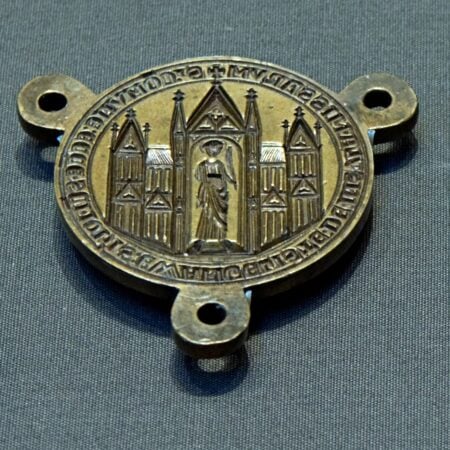
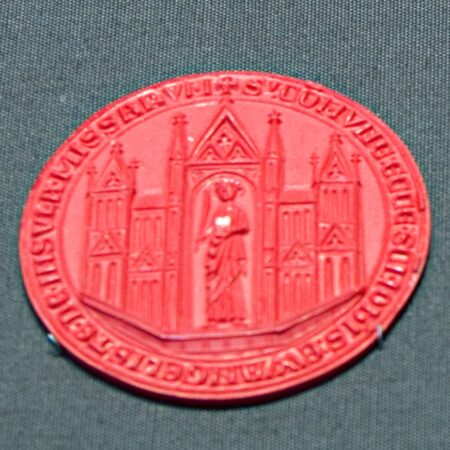
Signet rings have been a practical part of men’s fashion for thousands of years. For wealthy and important men, a signet ring was a powerful tool akin to a signature: the engravings on the ring were unique to the man who wore it, and if he used the face of the ring like a seal, he could stamp his symbol into ink, wax, clay, or similar surfaces, and in doing so leave a mark similar to the way that we sign documents today.
“A sense is what has the power of receiving into itself the sensible forms of things without the matter, in the way in which a piece of wax takes on the impress of a signet ring without the iron or fold.”
Aristotle
A signet ring differs from other rings because of its engraved or raised symbol, series of words or letters, or image on the top half of the ring that was representative of its wearer in some way. It could be a name, initials, job title, rank, organization, or family crest.
In the Modern Age, Signet Rings Are a Classic Style Icon
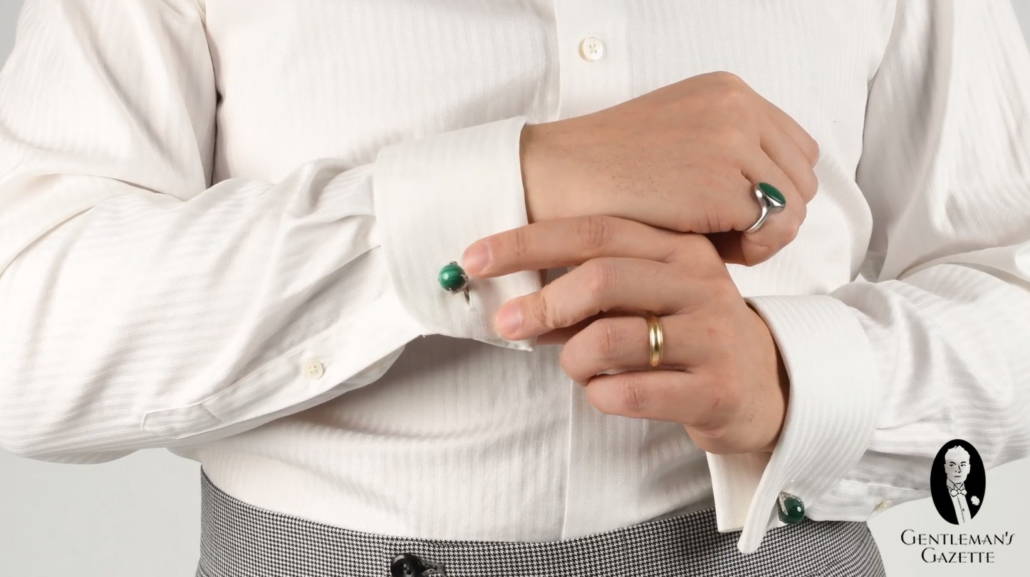
Changes in how documents and correspondence are verified and safeguarded mean that signet rings are no longer needed as practical tools to verify or secure documents. The signet ring, however, remains one of the most common types of rings in menswear, thanks in no small part to its unique and fascinating history.
Learn the do’s and don’ts of Classic men’s jewelry
The History of Signet Rings
The Origins of Signet Rings: Seals as Signatures
Historically, signet rings played a significant role in business and politics. Functioning as a seal, a gentleman would use his ring featuring his unique family crest, emblem, or monogram to stamp important documents. By dipping the ring into hot wax or soft clay, the ring left a distinct seal that was considered, at the time, to be more official than that of a signature, and this impression helped to solidify the authenticity of the sealed document. For this reason, signet rings are sometimes referred to as seal rings.
Signet Rings as Security Devices
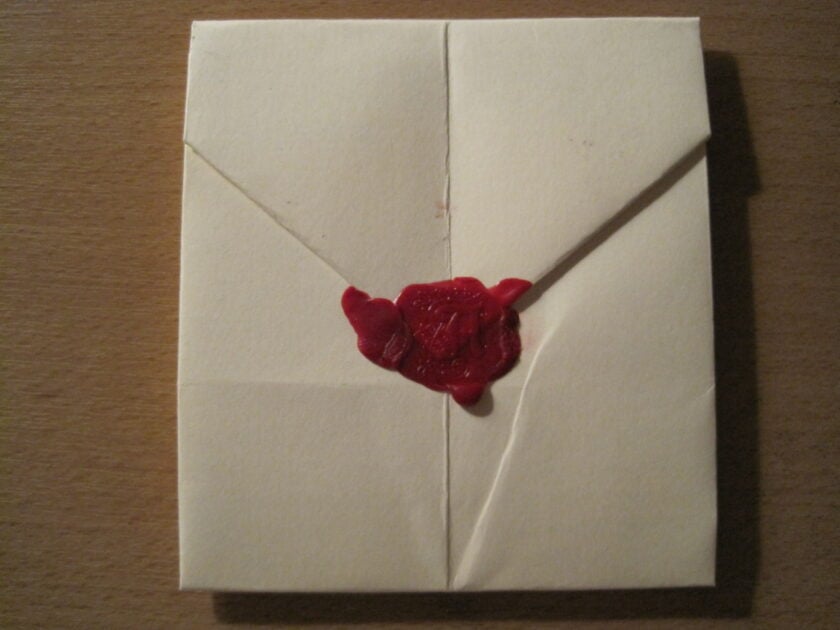
The wax or clay into which the impression was made was often placed in such a way as to effectively seal the documents or items on which they were impressed: for instance, over the flaps of a letter. If someone tampered with the item, they would have to literally break the seal, and because they did not have access to the original ring used to seal the item with an impression, they could not replicate the original seal and, therefore, could not hide the fact that the item had been opened.
In this way, signet rings and seals could be used almost like a security device, making it clear whether or not someone had tampered with an item or read a private letter. This functionality was one of the reasons signet rings were so valuable and of such monumental importance.
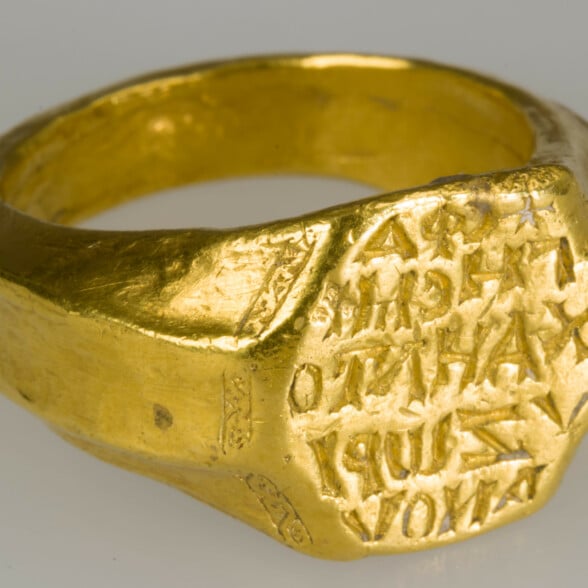
Why do some signet rings appear
Backward?
Because signet rings were intended to leave an impression on a different surface, historical signet rings were made with reversed faces. In this way, the impression left behind was “correctly” oriented for the benefit of anyone viewing it. Because signet rings are no longer used primarily for sealing documents, modern signet rings may or may not be reversed. Historically accurate rings with a mirrored face tend to be fairly expensive because they are difficult to make and relatively rare.
Signet Rings in the Ancient World
Sealing Cylinders and the Evolution of the Signet Ring
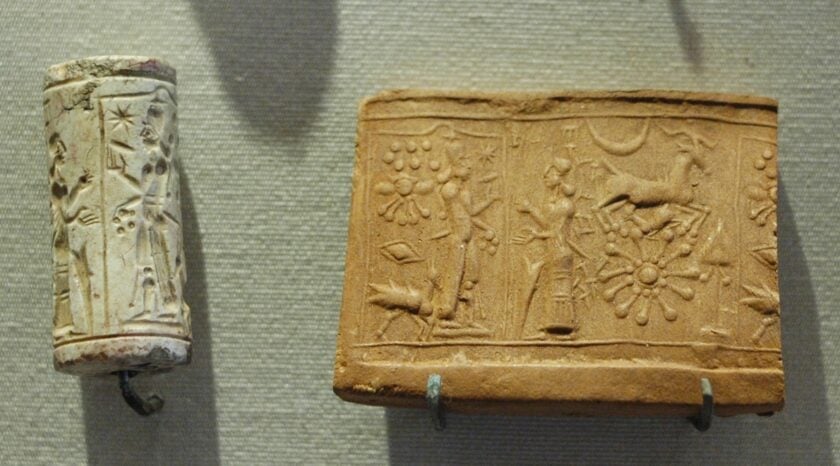
The origins of the signet ring can be traced back to around 3500 BC and the Mesopotamian civilization. To seal and authenticate documents, Mesopotamians would use a rolling seal, similar to a stamp. This cylindrical device was rolled across wet clay, leaving a distinct impression on it. Clay seals marked in this way were used to seal a variety of important items, including documents and packages for security and identification, as well as jars and containers to prevent tampering.
The Seal Becomes a Ring
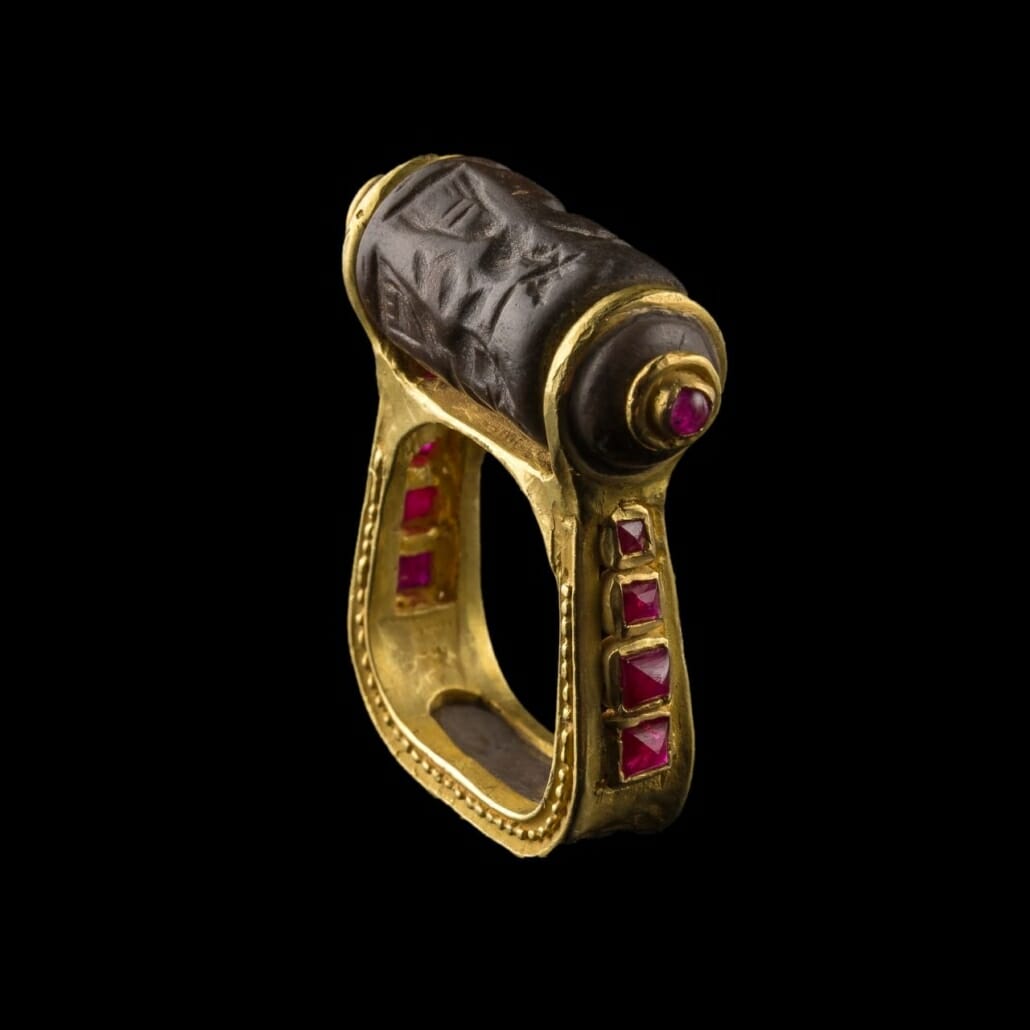
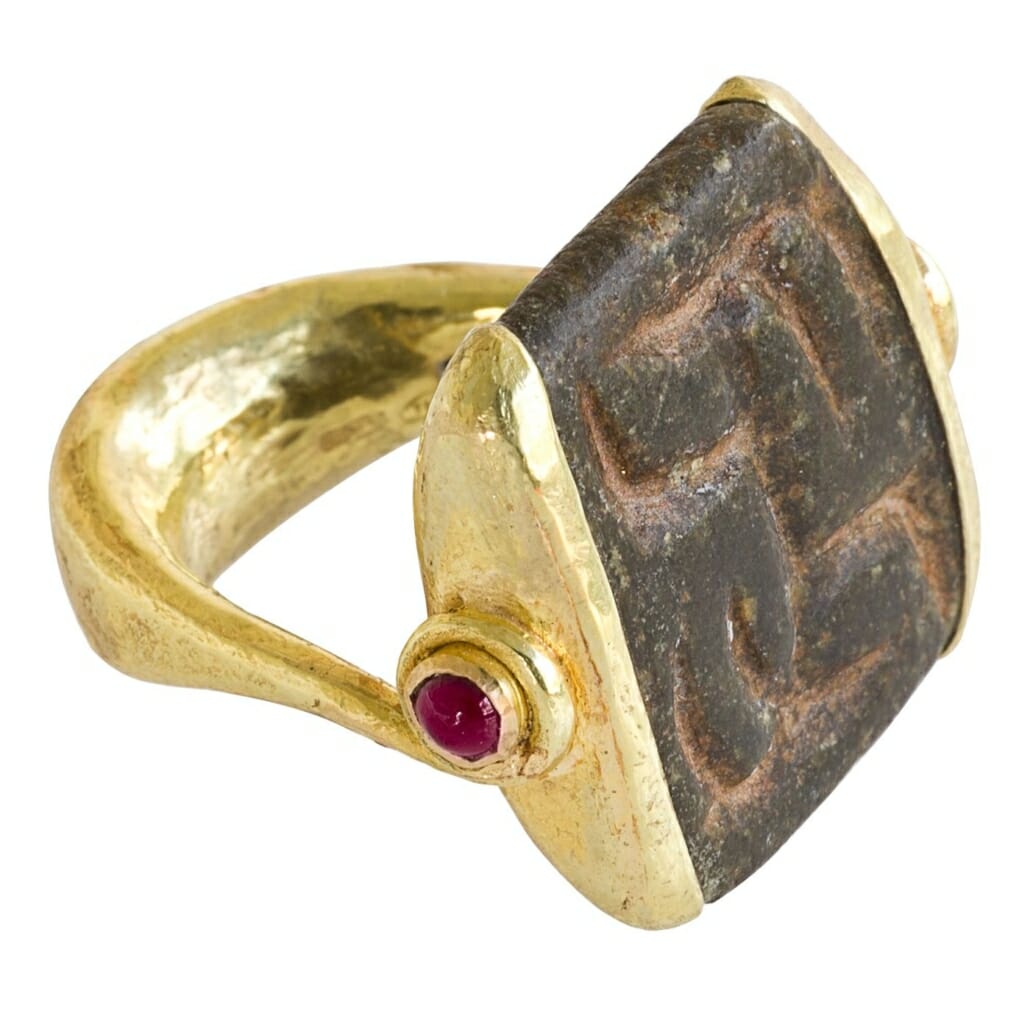
Because cylindrical seals were relatively difficult to carry around, the Mesopotamians made them more portable by placing the sealing elements onto rings. Not only were rings easier to carry around, allowing the seal to be literally on hand when needed, but they were also more secure: a ring could be worn on one’s person at all times to reduce the likelihood of misplacing the valuable seal or having it stolen.
Signet Rings of the Ancient World
Many great ancient civilizations employed signet rings in one form or another. In Ancient Egypt, pharaohs, religious leaders, and nobles would wear rings made of stone or a unique glazed pottery type called faience. The rings were flat on the outside and ornately decorated with hieroglyphics used to denote their owner.
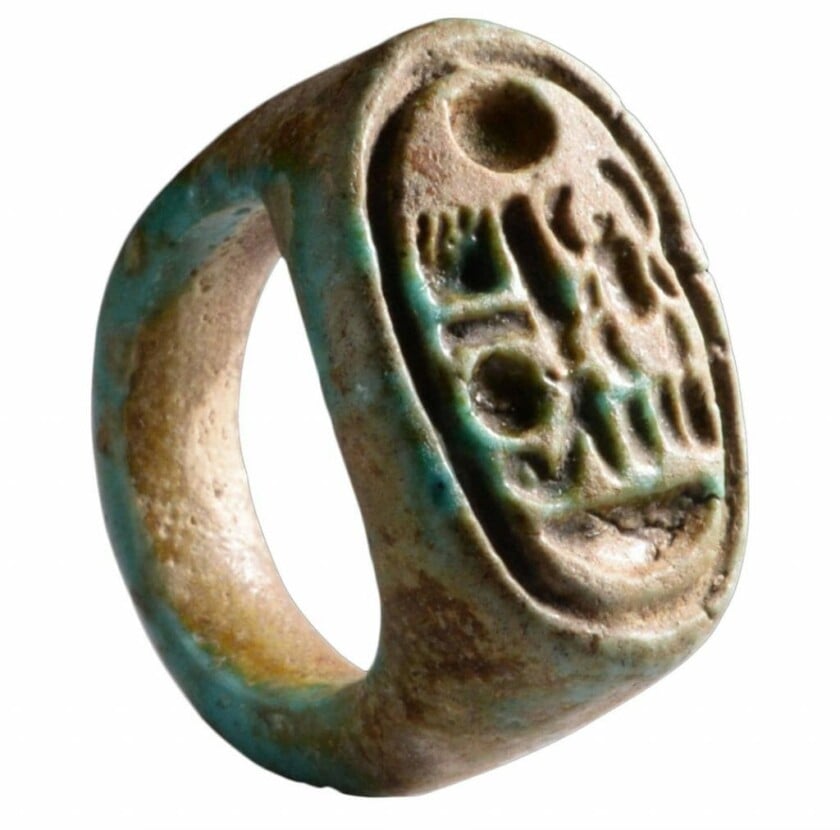
During the Early Minoan Age, from roughly 2900 to 2100 BC, signet rings were commonly chiseled out of stone or ivory. Within a few centuries, signet rings were made out of metal and closely resembled modern signet rings.
“And a stone was brought, and laid upon the mouth of the den; and the king sealed it with his own signet, and with the signet of his lords; that the purpose might not be changed concerning Daniel.”
The Book of Daniel, Chapter 6, Verse 17
Signet rings appear in the Bible and Torah, most prominently in the Book of Daniel, which is set around the 6th century BC. When King Darius orders that Daniel be thrown into a den of lions, a stone was placed over the den, and it was marked with a seal from the signet ring of Darius and his nobles. Sealing the stone in this way both illustrated that Daniel’s punishment was done under the king’s authority and could indicate whether or not anyone had broken the seal to move the stone.
Signet Rings Become an Art Form
During the Hellenistic Period in Greece and the Early Roman Republic, signet rings continued to be used as official seals, but they also began to take on a more decorative role, with an increasing emphasis on crafting rings that were beautiful to behold and helped to illustrate the wealth and power of their owner.
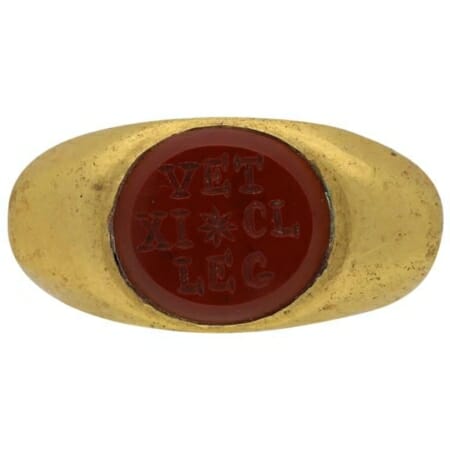
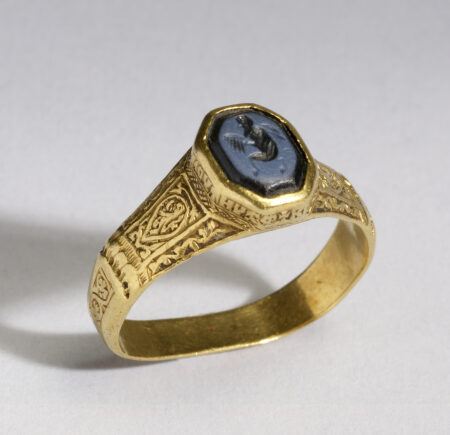
These signet rings had additional decoration, in the form of gemstones or scrollwork, that appeared on the rings in addition to the faces of the actual seal. While still functional, these signet rings were increasingly viewed as luxury items. In fact, the 1st century BC monarch Mithradates VI of Pontus was an avid collector of signet rings.
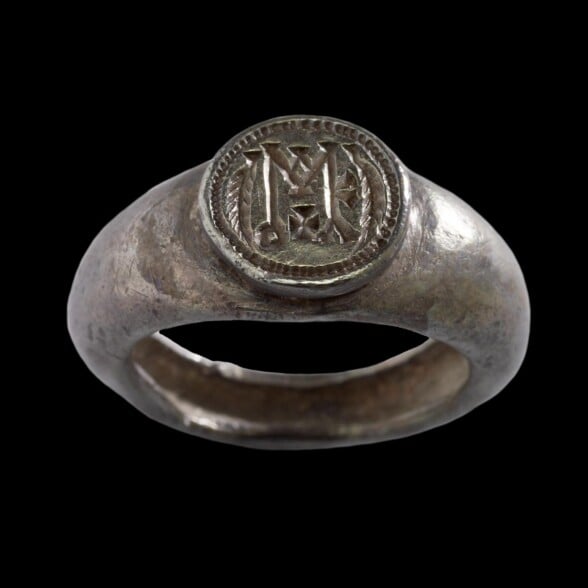
The origins of the word
Signet
The word “signet” in “signet ring” comes from the Latin word signum, which means “an identifying sign or mark” and is the origin of the English word “signify.” The suffix “et,” in this case, functions as a diminutive modifier that means “little.” A signet, therefore, is a “little symbol,” and illustrates the fact that the signet ring bears on its face a miniature version of the wearer’s symbol, or seal.
Signets Rings in the Medieval World
The Golden Age of the Functional Signet Ring
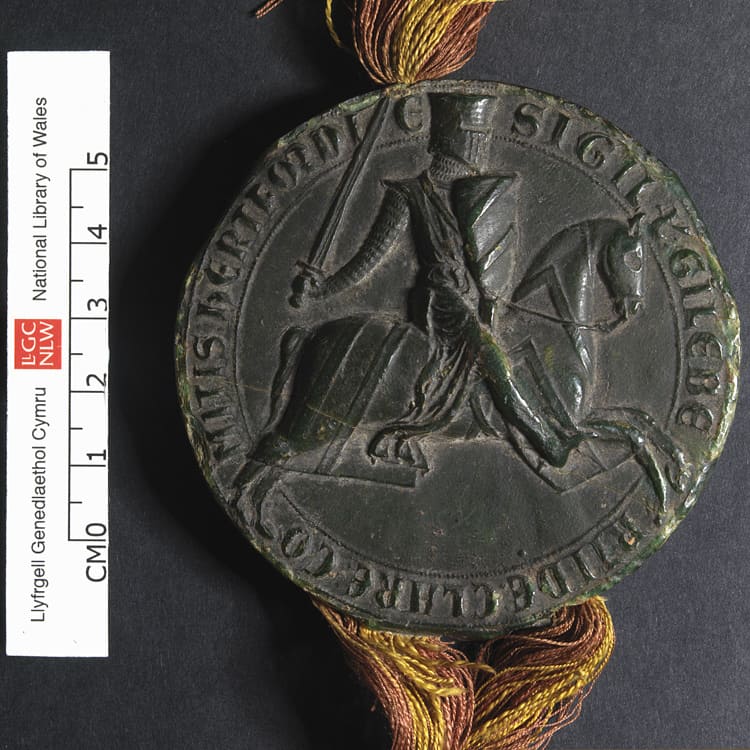
During the Middle Ages, as societies began to increasingly rely on the written word in the form of letters, decrees, patents, deeds, and histories, signet rings were an essential tool for determining what orders, transactions, and correspondence were genuine and authentic.
These signet rings were often decorated with the coat of arms of the wearer’s family, and were often extremely detailed: precise and fine detailing made it more difficult to make a forged copy of a signet ring, and the presence of little or obscure details could be used to verify the authenticity of a seal.
“By this gold ring I’ll prove it, which on my hand I wear”
The Nibelungenlied, 13th century High German Epic
Most members of the nobility, clergy, and military wore some kind of signet ring and used it to sign and seal anything that required security or authentication. In fact, the signet ring was widely considered the only authentic way to sign without concern of forgery or tampering. Even as more nobles learned to read and write, the signet ring remained the preferred method to validate a document and not a signature.
In fact, signet rings were so important and so associated with the legitimate authority of their owners that they were often destroyed upon the death of their owners. Signet rings were not often passed down through the family during this period because it was important that each family member have his or her own signet ring. Likewise, the rings could not be kept after the death of the wearer because then they might be used to forge documents.
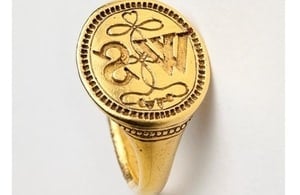
Did this signet ring belong to
Shakespeare?
On a spring day in 1810, a gold signet ring bearing the initials WS was found in a field in Stratford-Upon-Avon, a town in England. Stratford-Upon-Avon is famously the birthplace of celebrated English poet William Shakespeare, leading some to conclude that this beautiful gold ring once belonged to the Bard himself.
Evolving Impressions: From Relief to Counter-Relief
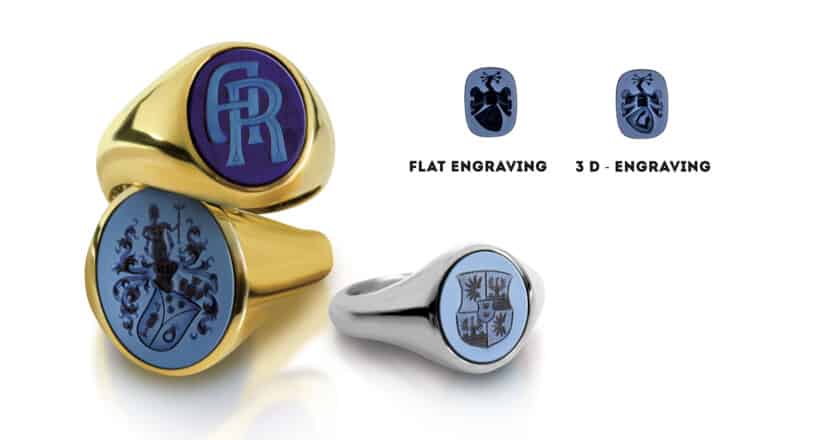
The earliest examples of signet rings were carved in relief, meaning that the impressed images were raised up relative to the “background” of the ring’s face. This was done because early signet rings were pressed into harder substances like clay, and a raised stamp was needed to leave a strong impression. This also meant that the rings themselves had to be very durable and resistant to damage, as they were constantly jammed into the matrix for sealing.
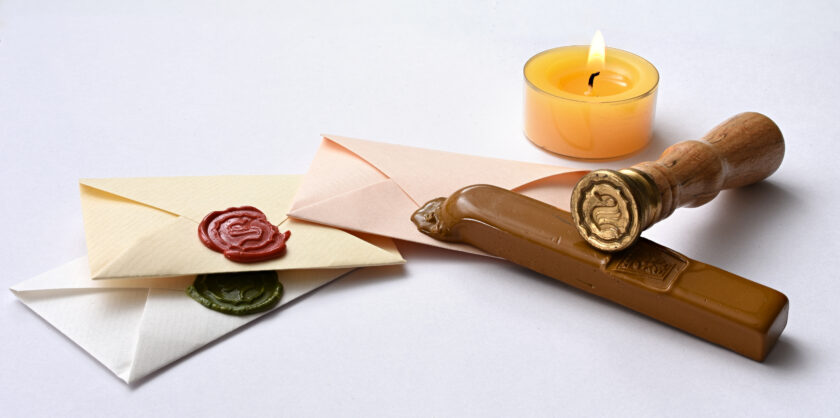
During the Roman Period, bitumen, a sticky, black, highly viscous material derived from petroleum that is similar to tar, was increasingly used for seals because it was softer and more malleable. Eventually, sealing wax, an organic compound derived primarily from the wax in the honeycombs of bees, became the preferred seal material.
“Some people thrust several rings upon the little finger alone; while others wear but one ring upon this finger, the ring that carries the seal upon the signet ring itself….”
Pliny the Elder
Sealing wax was so soft that it was no longer necessary to have a raised impression on the sealing face of the signet ring. Therefore, it became increasingly popular for signet rings to be cast in counter-relief, or intaglio, in which the symbol was recessed into the face of the ring. When the ring was pressed into the soft wax, the wax filled into the vacuum of the casting and left a raised imprint in the wax itself.
Signet Rings in the Modern Era
The Changing Role of Signet Rings

During the 17th and 18th centuries, signet rings were slowly being replaced by signatures as the preferred method for verifying and authenticating documents. Signet rings remained important symbols of authority, however, and correspondence continued to be sealed with wax as a safeguard against tampering.
With their functional purpose decreasing somewhat, signet rings soon became more heavily decorated and bejeweled than ever before. Valuable and expensive signet rings were passed down through families as heirlooms, and some signet rings became so heavy and ornate that they were worn on chains or fobs rather than on the fingers.
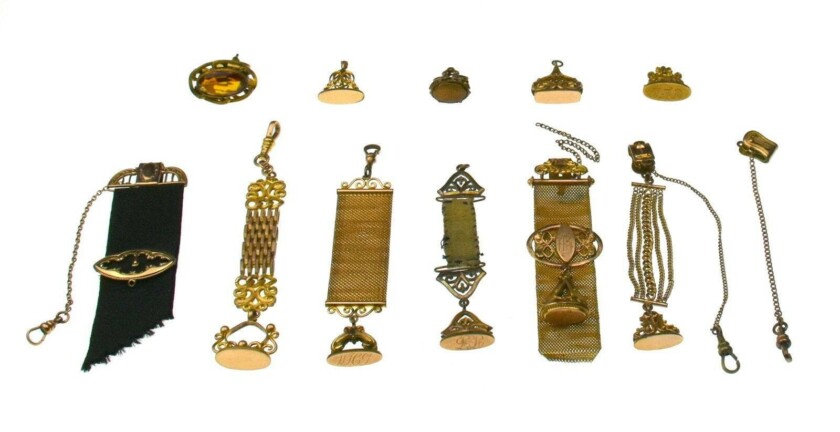
Victorian Signet Ring Customs

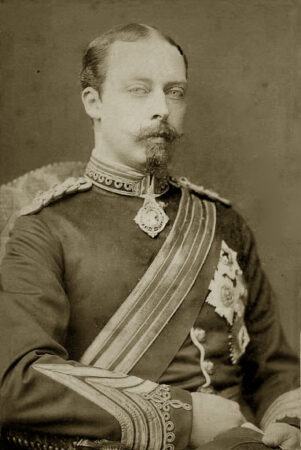
Many customs and designs that we associate with signet rings today were developed during the Victorian Era. At this time, most signet rings were made from precious metals like gold or silver, with faces in either the ring’s metal or carved from precious or semi-precious stones like rubies, bloodstone, or carnelian, that were fastened to the ring.
Signet rings from this period would still feature coats of arms or heraldic animals, although initials or monograms were also becoming increasingly popular.
Prior to this era, because of their size, signet rings were often worn on the index or middle finger. By the 19th century, however, signet rings were usually worn on the pinky finger of the left hand in England and the ring finger of the left hand in North America and Germany: on the rest of the Continent, traditions varied regionally, although either pinky finger was a popular option.
Signet Rings in the 20th Century
During the 20th century, signet rings remained a popular menswear accessory that was commonly worn by gentlemen in the upper classes but also by upwardly-mobile men who wanted to fit in with high society.
“He spent the time examining Dickie’s rings. He liked them both: a large rectangular green stone set in gold on the third finger of his right hand, and on the little finger of the other hand a signet ring….”
From The Talented Mr. Ripley by Patricia Highsmith
What did we think about the style of The Talented Mr. Ripley?
Along with wedding rings, signet rings were one of the most popular and easiest-to-wear rings for men to employ, and so they were a common sight through the Golden Age of Menswear. These rings were usually worn on the pinky or ring finger and were often intended to be luxury items made from gold, silver, or platinum with the addition of gemstones and fine detailing.

The Signet Ring Today
Signet Rings Still Have a Place in Contemporary Menswear
In the 21st century, signet rings are only used to seal documents as a fun hobby, and very few people outside of select groups of nobles or royals employ them as symbols of aristocratic power or authority. They remain, however, a versatile and stylish option for men interested in wearing a greater variety of rings.
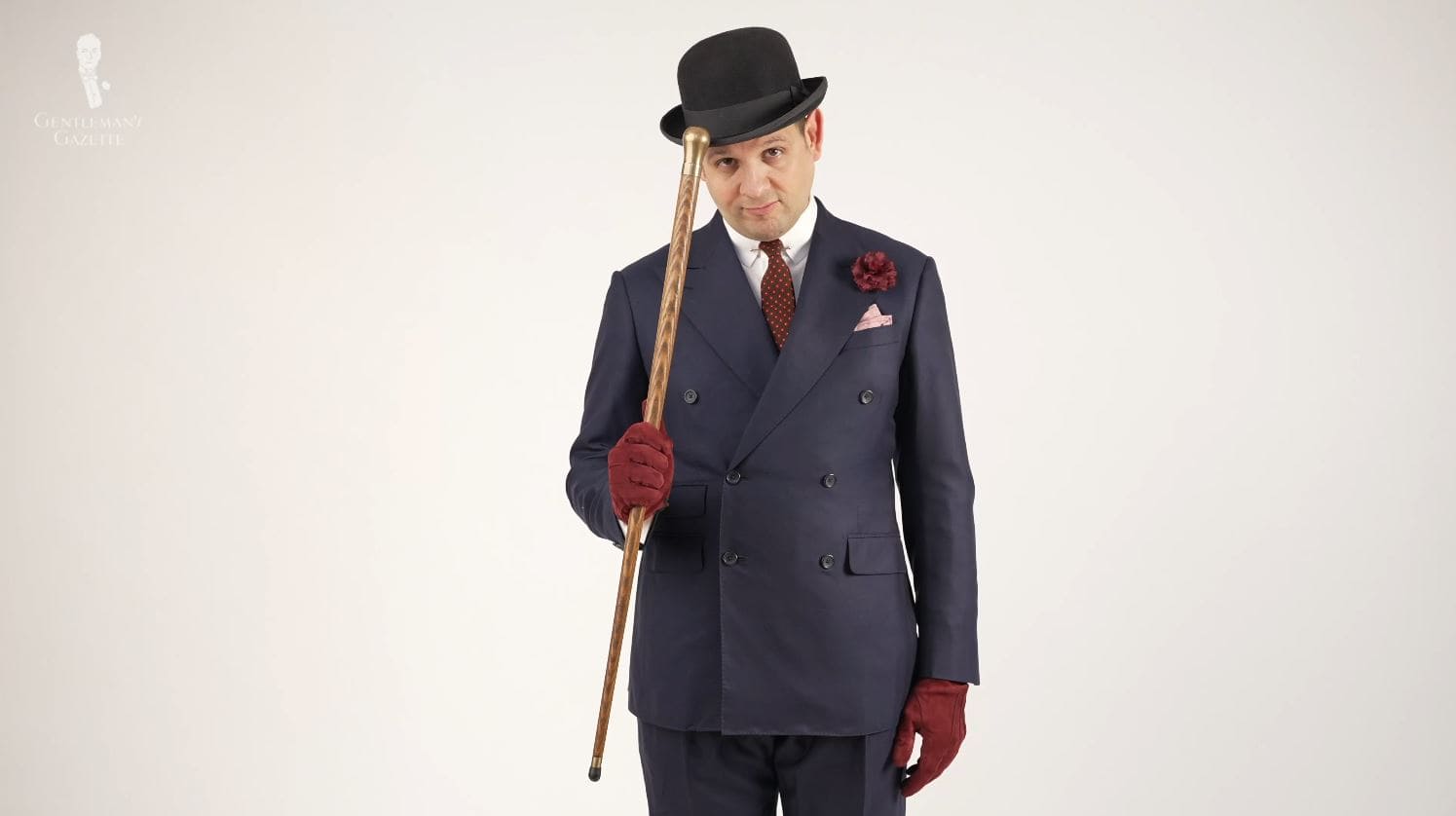
Vintage Flair and Family History
Many people who wear signet rings today like them because they have a historical, traditional aesthetic that is evocative of lordly living, stately manners, and a more refined past. These gentlemen admire the history behind the signet ring, and enjoy vicariously participating in it by wearing this historical ring type.
Of course, some families do have signet rings that genuinely represent their families, as these rings are often passed down through the dynastic line as a treasured heirloom that represents the lineage of the family and all that its many members have achieved.
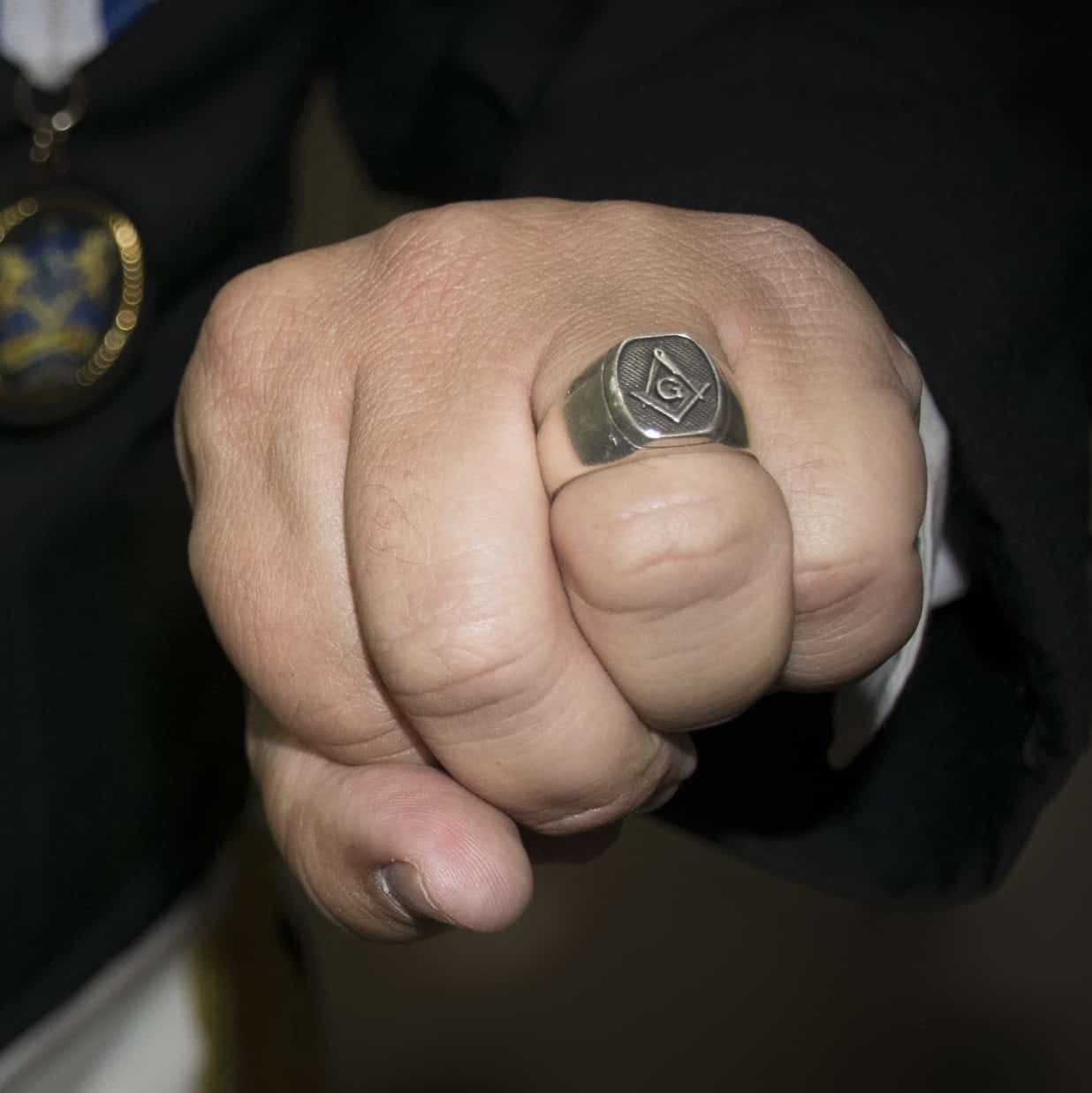
Institutions, Clubs, or Associations
Some clubs, corporations, and institutions give signet or seal rings as gifts upon a certain length of service, a graduation, or a commendation. This not only honors the wearer, it also advertises the institution to others. Many military men will also wear signet rings that reflect their rank or showcase the branch they served with, similar to a class or service ring.

Personal Style Choice
For many other people, however, a signet ring is simply a unique ring choice that has lots of personality and offers opportunities for unexpected decoration or visual interest. Relatively few contemporary rings have noticeable symbols or images displayed on them, so signet rings are a great way to inject an artistic element into one’s outfit, regardless of the history of the symbols or what they meant historically.
However you choose to wear your signet ring, this unique article can be a great addition to your wardrobe and will always add charm and panache to any Classic outfit.
Signet Ring FAQ
What is a signet ring?
A signet ring is a ring with a prominent, flat face depicting some kind of symbol or letters that represent something else, like a family, company, school, or institution. Originally, signet rings were used as seals, in which the image on the face would be impressed into ink, soft clay, or wax to stamp a mark as a way to effectively “sign” one’s name, legitimize, or safeguard against tampering whatever was marked. Today, signet rings refer to any ring with a similar design, even if it is not intended to literally seal anything.
Why are the images on many signet rings reversed?
Because signet rings were originally used to leave impressions as seals, the image on the ring’s face is often reversed so that, when the impression is made, the stamped image is correctly oriented for the viewer.
What is the meaning of a signet ring?
Most technically, a signet ring is intended to represent, usually through the images or letters on it, a person, family, institution, or association. In practice, however, signet rings do not have to have any special meaning or significance. A signet ring can simply mean that you like the style of the ring and enjoy wearing it.
Are signet rings still popular?
Although men, in general, are wearing less jewelry today than during the Golden Age of Menswear, signet rings are, next to wedding and class rings, one of the most popular rings worn by contemporary gentlemen. They are, therefore, a great option for most men, especially men who are experimenting with men’s jewelry for the first time.
Is a signet ring the same thing as a pinky ring?
No, it is not. Although, especially in the Anglophonic world, many signet rings are pinky rings, a pinky ring is simply any ring that is worn on the pinky, while a signet ring is any ring that bears a seal-like face. Signet rings can go on any finger, although nowadays, they are traditionally worn on either the pinky or ring finger, and historically, they were often worn on the index finger.
Do you have to be rich or important to wear a signet ring?
No! Anyone can wear a signet ring, either as a personal choice or simply as a style choice.
Are signet rings pretentious, snobby, or tacky?
Because signet rings were historically worn by entitled noblemen, it is sometimes assumed that anyone who wears a signet ring is snobby or elitist. In reality, however, signet rings, like all types of rings, are worn by a variety of men for a variety of reasons.
On which finger is a signet ring worn?
The finger on which a signet ring is worn varies by culture and time period. Historically, in Europe, signet rings were often worn on the index finger or middle finger. Nowadays, most signet rings are worn on the pinky ring of either the left or right hand, with the left hand associated especially with England, or the ring finger of the left or right hand, with the former associated with Germany and North America.
Are there rules about who can wear a signet ring?
Historically, one had to hold a particular office or be a member of a particular noble family to wear a signet ring because the signet ring represented those institutions. Nowadays, however, anyone can wear any signet ring that they choose.
How can I wear my signet ring with my wedding ring or other rings?
There are many different ways to wear multiple rings on your fingers. If the rings are the right size, you can stack them, wearing two rings on the same finger. In England, both signet and wedding rings were traditionally worn on the pinky finger. If you are wearing a wedding ring on your ring finger and you usually wear your signet ring on the pinky finger of the same hand, you may want to move the pinky ring to the opposite hand to ensure that the rings do not rub against each other.
What does wearing a signet ring say about you?
Traditionally, signet rings are used to express family associations, either with a genuine family coat of arms or an imagined one. Therefore, signet rings often represent men who have a strong connection to their family, heritage, and history. This is only an association, however, and signet rings can have essentially any meaning or significance that the wearer desires.
Who Can Wear Signet Rings? You Can!
Signet Rings Have Become a Versatile Jewelry Option for All Men
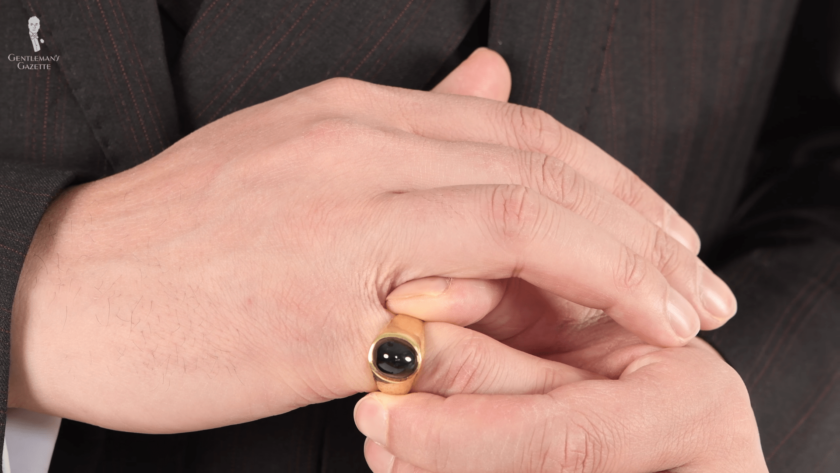
Although originally associated with individual families, governments, or institutions, today, signet rings of all kinds can be worn by anyone. You do not have to be a nobleman yourself or a member of a particular family to wear a signet ring that depicts a particular crest or coat of arms.
“Personally, my family never had a crest, and I never felt the need to create a signet ring with something that was so personalized and old-fashioned. I really like to wear rings, and I even have a bunch of rings in my collection that are made to be signet rings; I simply prefer them without an engraving.”
Raphael Schneider, Founder of the Gentleman's Gazette
If you like the design of the British royal coat of arms, you should feel free to wear it, even if you are not a Windsor yourself. Likewise, if you see a signet ring with a lion or other animal that you enjoy on it, feel free to wear the ring simply because you like the design.
Check out Raphael’s ring collection!
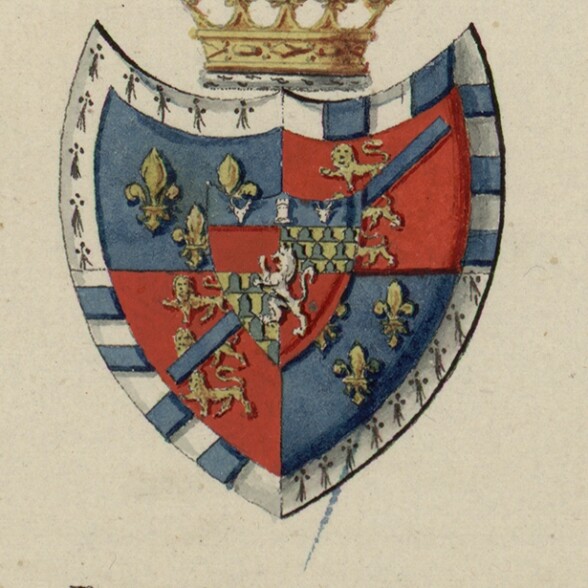
What if I don’t have a family
Coat of Arms?
While some families do have an official coat of arms, you do not need to be descended from nobility to enjoy one today. It is perfectly acceptable for you to wear a historical coat of arms on your signet ring if you like the design. Doing so does not mean that you are posing as a member of that family, it only means that you admire the stylistic design of their crest. If desired, you can even design your own family crest! After all, even the oldest and noblest of families had to start somewhere.
The Benefits of Wearing a Signet Ring
- It is a anique menswear accessory that adds visual interest to your hands, one of the most active parts of your body.
- It is a great conversation starter and a way to subtly tell others about your personality and interests.
- It is a simple and easy way to expand your usage of jewelry in a classic, traditional way.
- It is, along with a wedding or class ring, one of the most common rings in menswear.
- It can Expand pairing opportunities with other metallic items like cufflinks or collar jewelry.
How to Wear a Signet Ring
Although Conventions Exist, the Final Choice is Yours
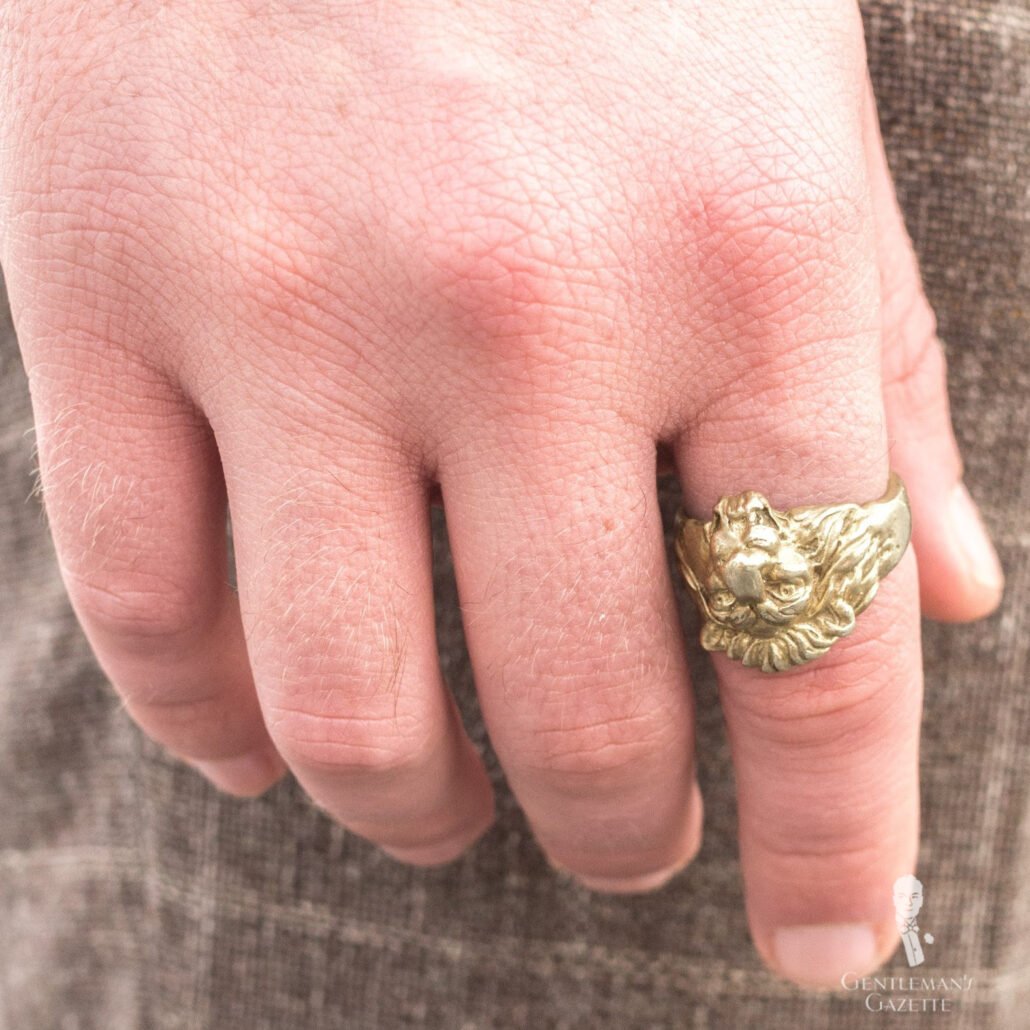
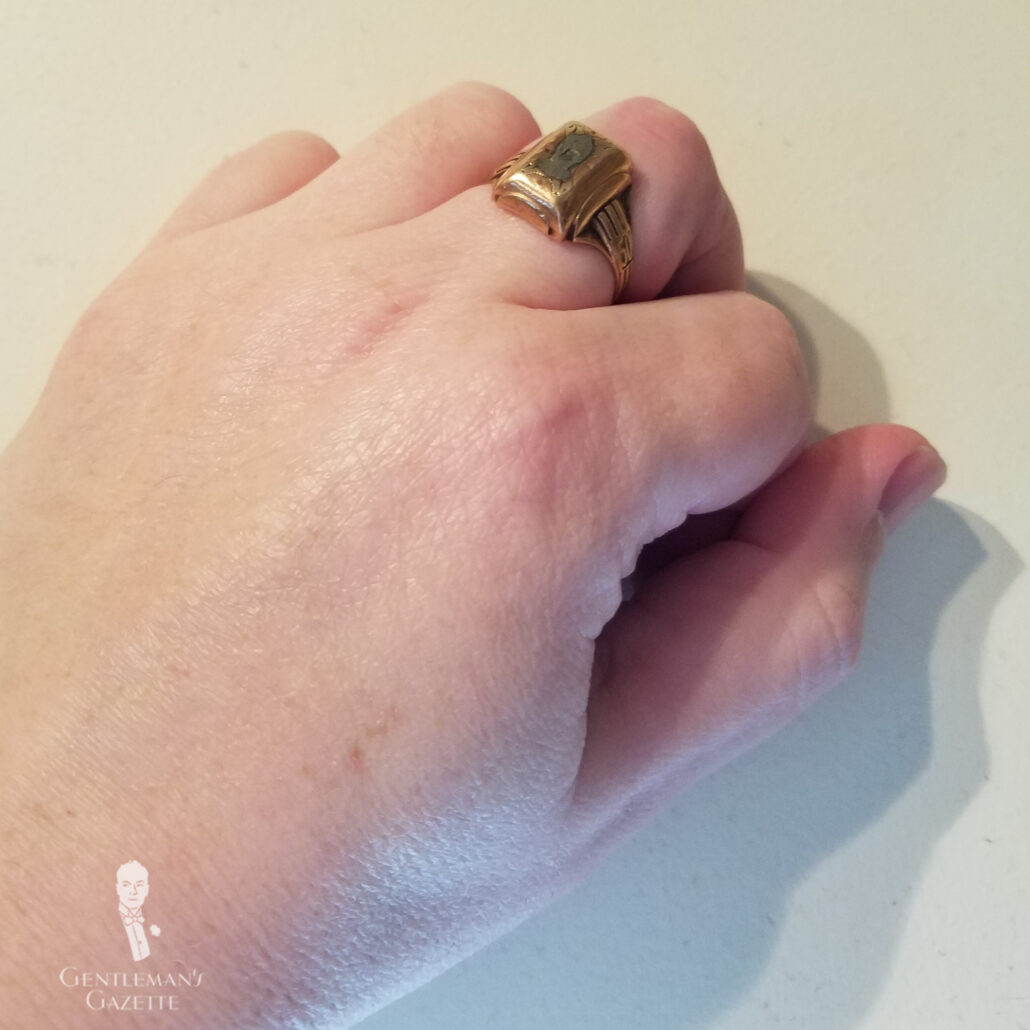
Because signet rings have been worn for millennia and were such important aspects of multiple societies’ cultures and histories, many conventions, guidelines, and traditions have arisen about how they should be worn. Ultimately, however, how you choose to wear your signet ring is your choice. We provide the following information only so that you can be informed as you make your decision.
Traditional Fingers for the Wearing of Signet Rings
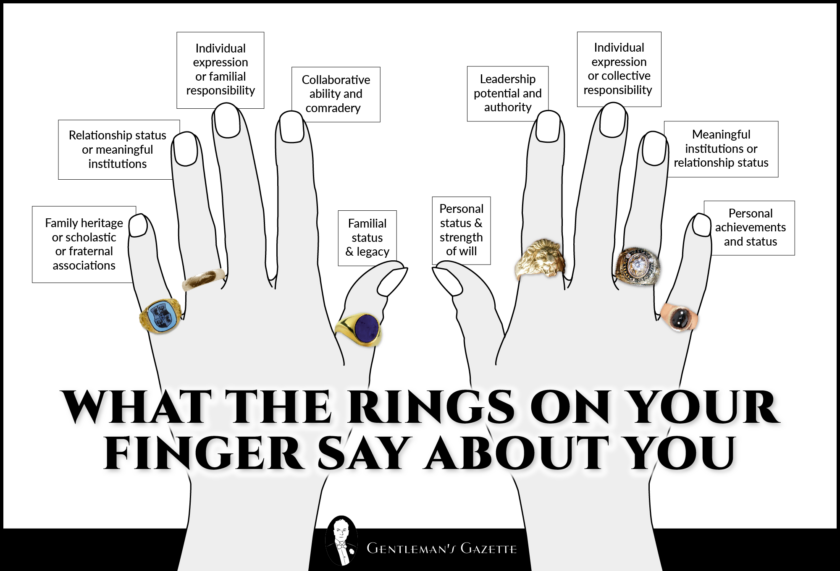
Historically, signet rings were usually worn on the index or middle finger because the seals on the faces of the rings were extremely large. During the Modern Era, signet rings shrank somewhat in size and were often worn on the ring fingers or the pinky fingers, with variable traditions based on geographic location.
| Country | Finger |
|---|---|
| England | Pinky finger of the non-dominant hand |
| France | Ring or pinky finger of the left hand. |
| Germany | Ring finger of left hand. |
| North America | Ring or pinky finger of left hand. |
| Switzerland | Ring finger of the dominant hand |
Does the finger you wear your ring on really matter?
How to Wear Multiple Rings
Along with a signet ring, you may find yourself wearing a wedding ring, a class ring, and perhaps even more rings. For a Classic look, you should consider wearing these rings in a balanced way that visually distributes them across your hands.
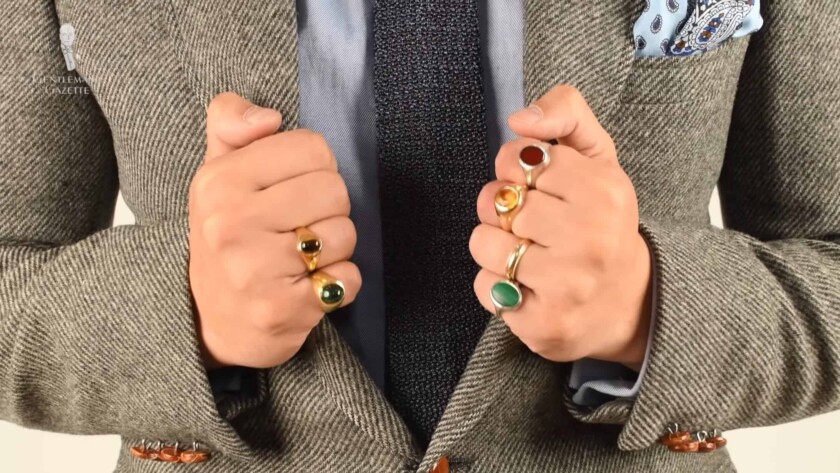
For instance, rather than wearing rings on your pinky, ring, and index finger of your left hand, consider moving one or two rings to your right hand. Note also that a wristwatch, especially one with a metal bracelet, can visually balance out one or two rings. Therefore, a wristwatch on your left hand could be nicely balanced by a ring on the index finger and pinky finger of your right hand.
Traditionally, a gentleman would wear one ring on each hand, such as a wedding ring and a signet ring. If desired, he could add a third ring, wearing one ring on the arm that also wore his wristwatch and wearing two rings on the other hand. This arrangement encourages balance and is very visually appealing, ensuring that your hand jewelry does not appear cluttered.
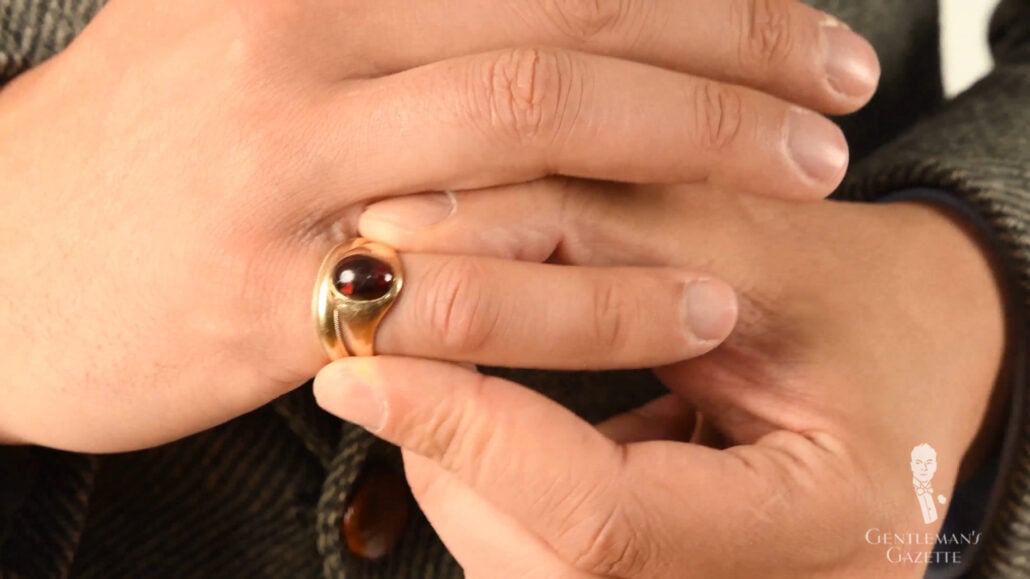
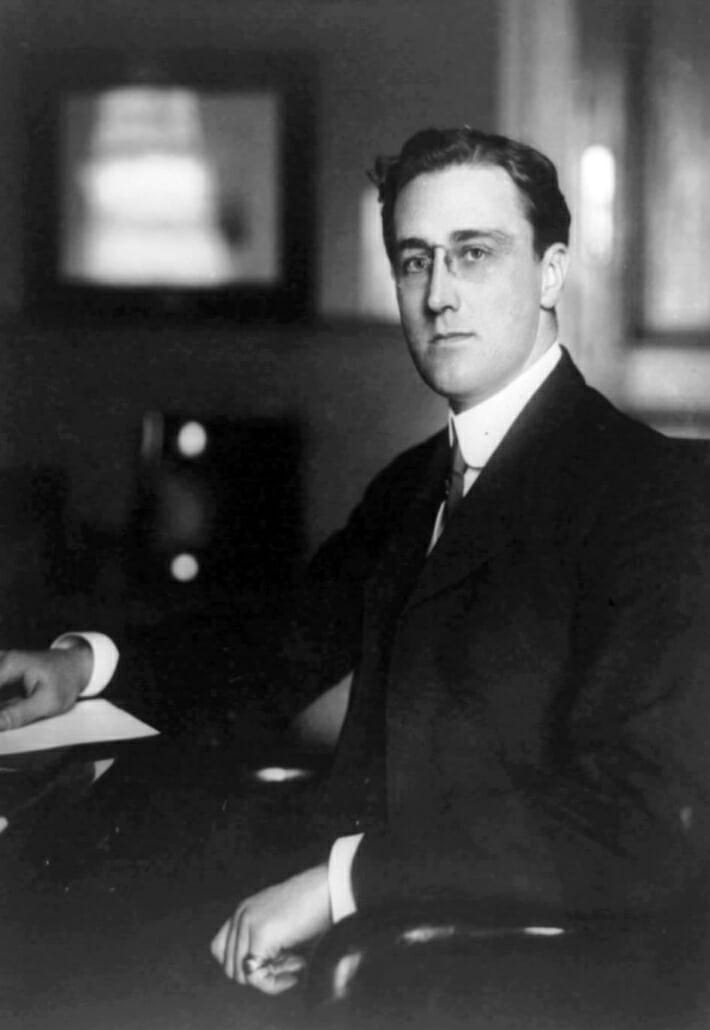

Ring Rules are more like
Guidelines
Remember that you can wear any ring on any finger that you want, especially if you prefer breaking the mold or being more individualistic. The famous British prime minister Winston Churchill wore his signet ring on the ring finger of his ring hand, even though the English tradition called for wearing it on his pinky. Men have worn signet rings on every finger throughout history, so whichever way you choose to do it is correct.
Contemporary Signet Ring Design
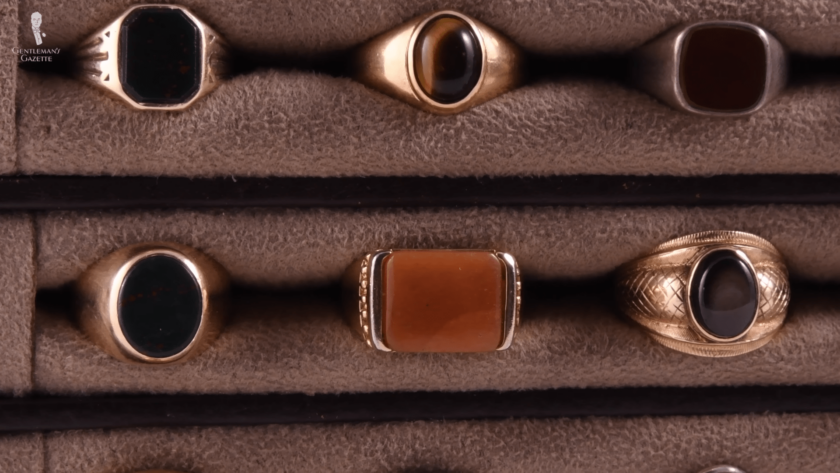
Although no longer used primarily to seal documents, the contemporary signet ring still closely resembles its historical ancestor. On the band, the signet ring features a flat face on which the seal would traditionally appear: nowadays, it is not uncommon to find signet rings with unadorned faces that lack any kind of seal.
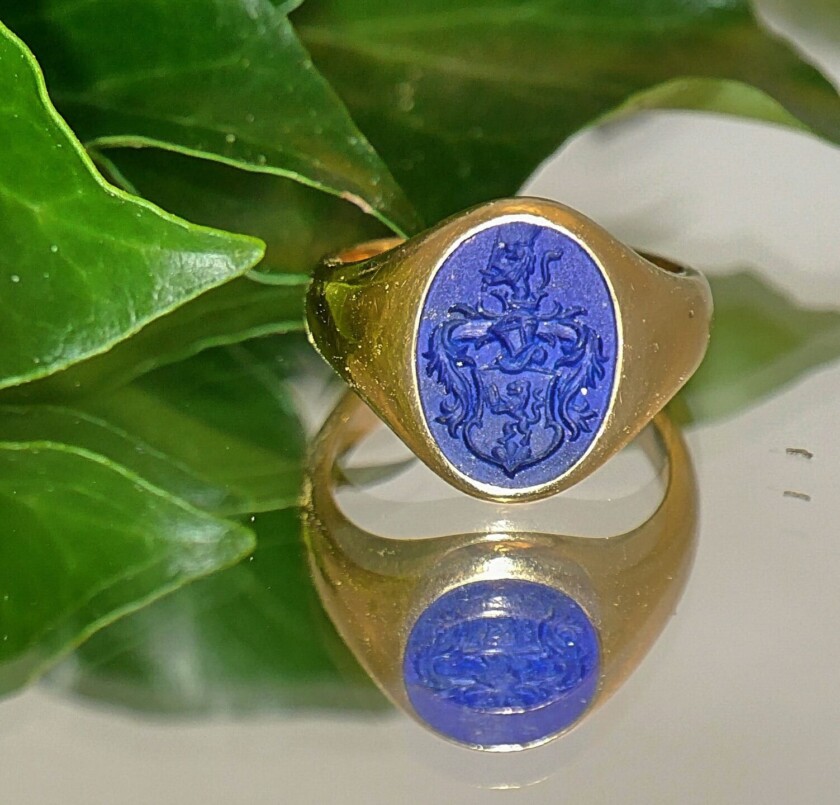
The face can be made from the same metal as the ring, a different metal from the ring, or with an inset, usually a precious or semi-precious stone. As previously mentioned, this face can be decorated or plain.
Interested in pinky rings?
Common Signet Ring Materials
Metals
Signet rings can be made in any material from which rings can be made, although traditionally, they were crafted from precious or semi-precious metals like gold or silver.
Gold
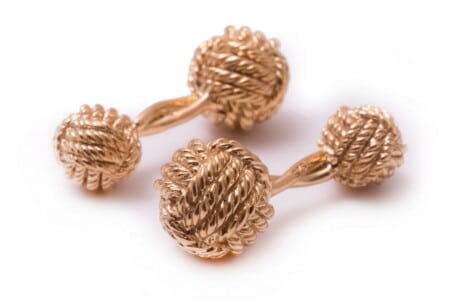
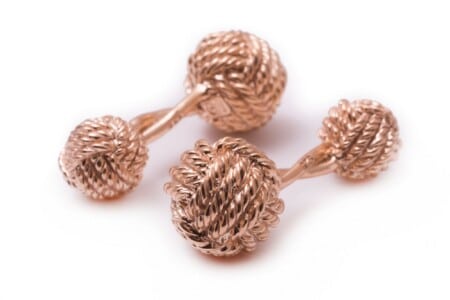
Gold signet rings are the most typical. Your primary choices will be between gold purity and gold luster. The traditional lusters are white gold, rose gold, and yellow gold, and ultimately, this choice is a purely aesthetic one.
Gold purity refers to the relative proportion of gold in the alloy used to make the ring. This system is referred to as karats, with 24 karats representing effectively pure gold. Because gold is extremely soft, a true 24-karat ring would easily warp during regular wear, and so an alloy is often preferred.
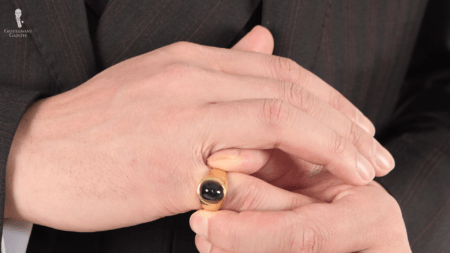
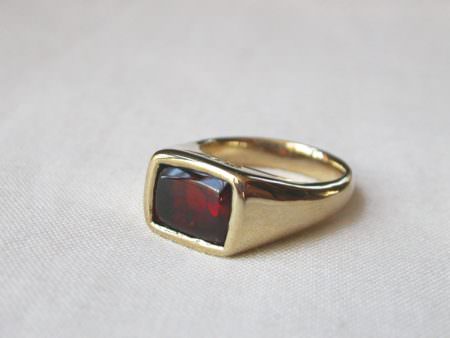
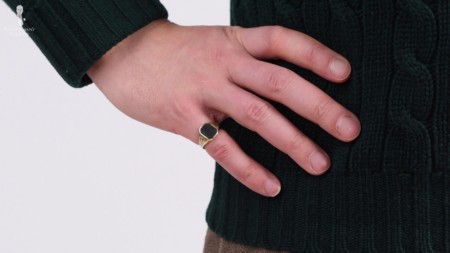
The common karats for rings are 10 karats, 14 karats, or 18 karats. Rings with higher karats often have a more pleasing, refined appearance in which the unique characteristics of the gold luster are especially prominent, but they also tend to be more expensive and easier to scratch or bend.
Rings with lower carats are cheaper and more durable, but they also tend to have a more dull appearance and tarnish more quickly.
Silver
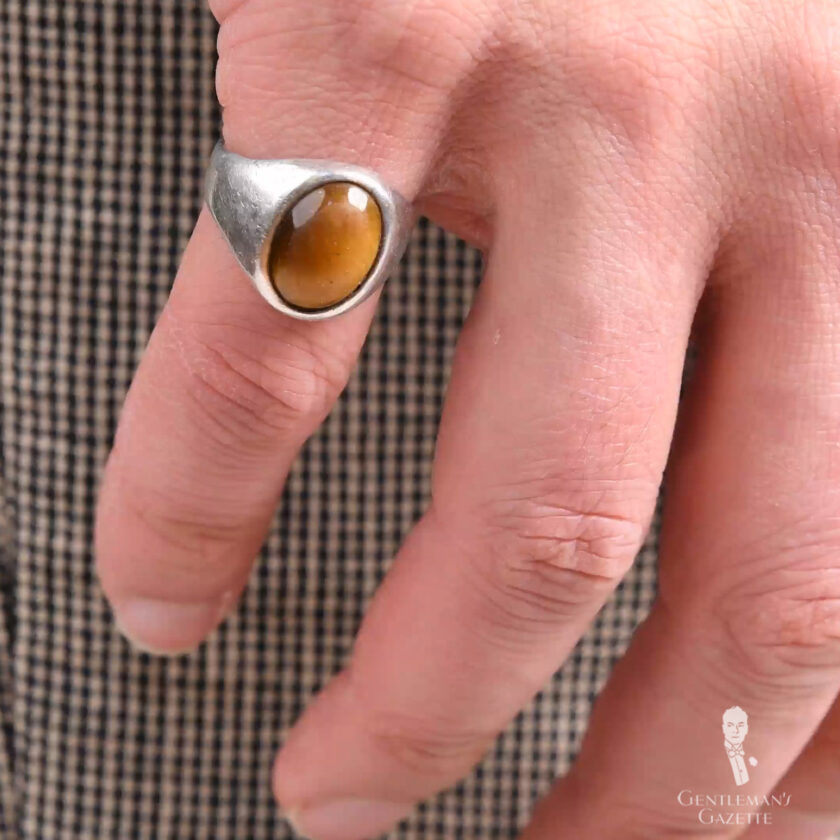
While silver lacks the luster variations of gold, it does have a purity scale, although it is not ranked according to karats. Instead, silver is rated according to fineness, with a maximum fineness of 999, or 99.9% silver. Most jewelry-grade silver will have a fineness of at least 925.
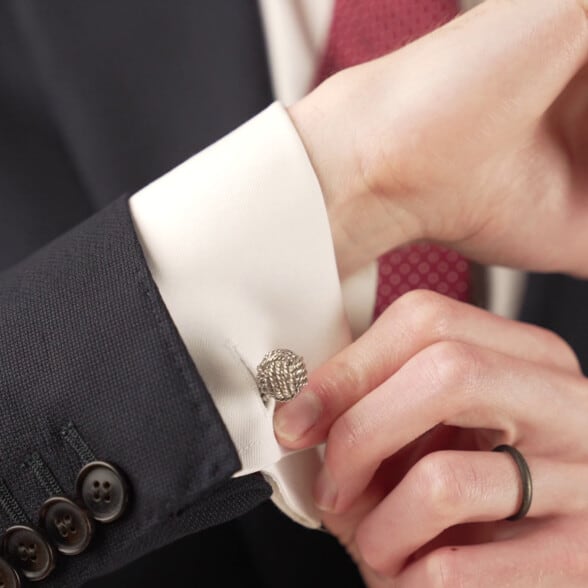
Consider the benefits of
Silver Plating
Silver tarnishes extremely easily, and so it is increasingly common to find silver jewelry like rings plated with another metal, such as palladium or platinum. This process reduces the need to constantly clean and polish silver without adversely affecting its unique ethereal shine or luster. In many cases, silver-plated jewelry is a hallmark of quality craftsmanship and attention to detail.
Stones
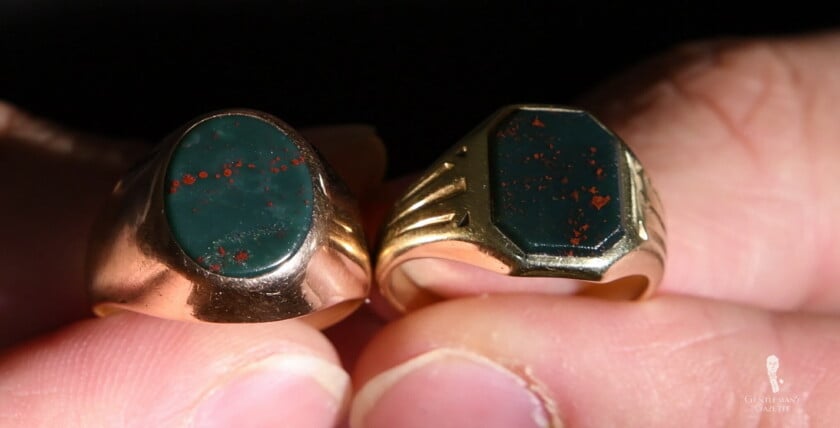
If a signet ring does not have a metallic face, it will usually have a face made from a precious or semi-precious stone. This choice is essentially an aesthetic one, and the common options include black onyx, blue lapis lazuli, green and red heliotrope, and red carnelian.
Common Signet Ring Styles
Face Shape
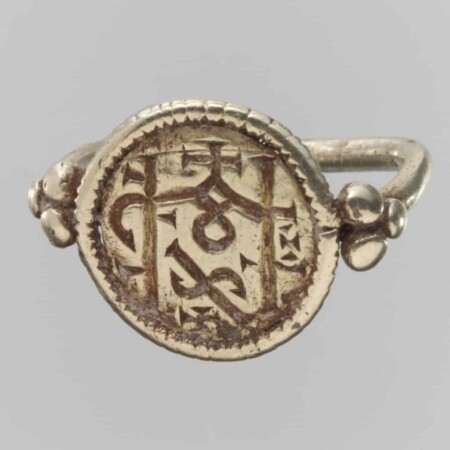
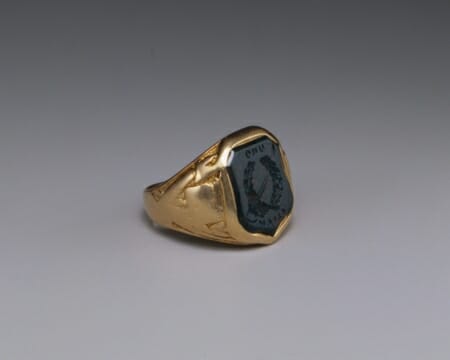
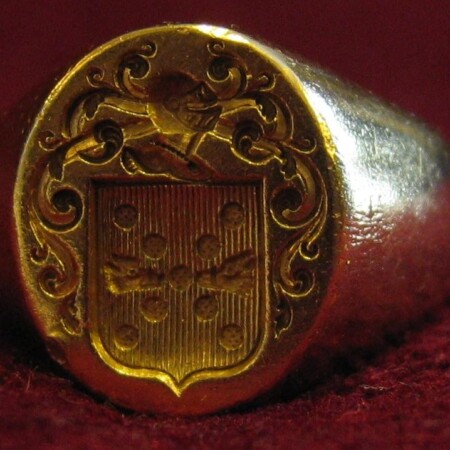
The most prominent feature of a signet ring will be its face shape. Historically, the following six face shapes were employed and have remained popular up to the present day:
- Straight Oval: The most popular signet ring shape, partly because it is easy for the engraver to work.
- Bulbous Oval: A heavier, more distinctive-looking oval that is nearly round.
- Round: A simple, elegant shape that can appear both modern and antique.
- Cushion: Favored during the Victorian Era, this shape is the second-most common, after the Straight Oval.
- Oxford: This heavy, blocky shape resembles a solid square or rectangle with rounded corners.
- Octagon: A very modern style not often seen on vintage rings.
Engravings on the Face
Signet rings can have any kind of design on their face, including no design whatsoever, and traditionally, these designs would be rendered on the face in one of two ways.
| Relief | Counter-Relief |
|---|---|
| In this style, the engraver will carve away or cast the face material so that the design is raised up three-dimensionally from the “background” of the face. Relief work tends to be slightly more expensive, but the results are very ornamental and highly sculptural, ensuring a unique and attractive signet ring. | In this style, the engraver will carve into or cast through the “background” of the face, creating a design that is sunken into the face of the signet ring. This style was favored for historical signet rings used with sealing wax, and therefore has a distinctive, traditional charm. |
Setting Reverse
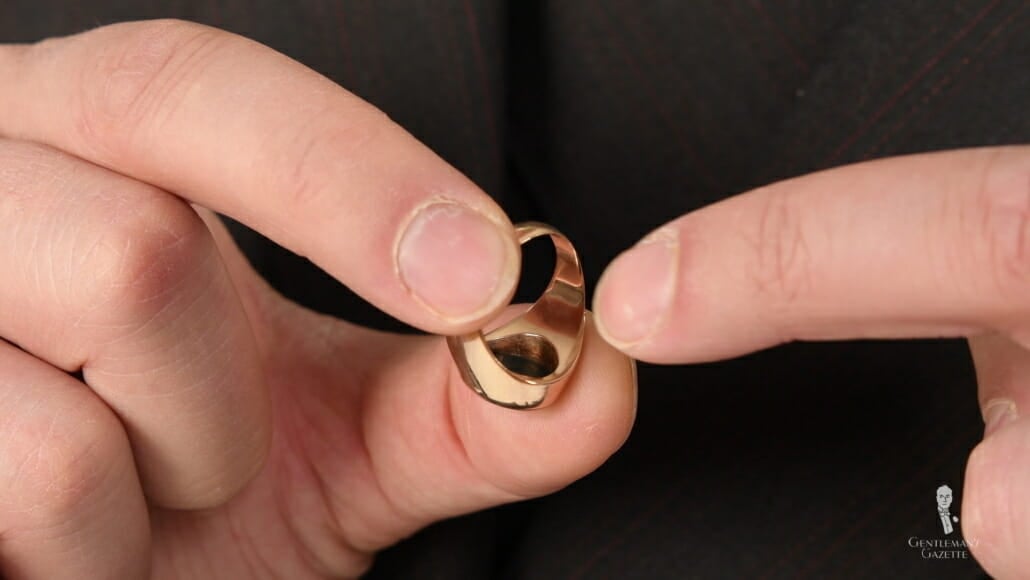
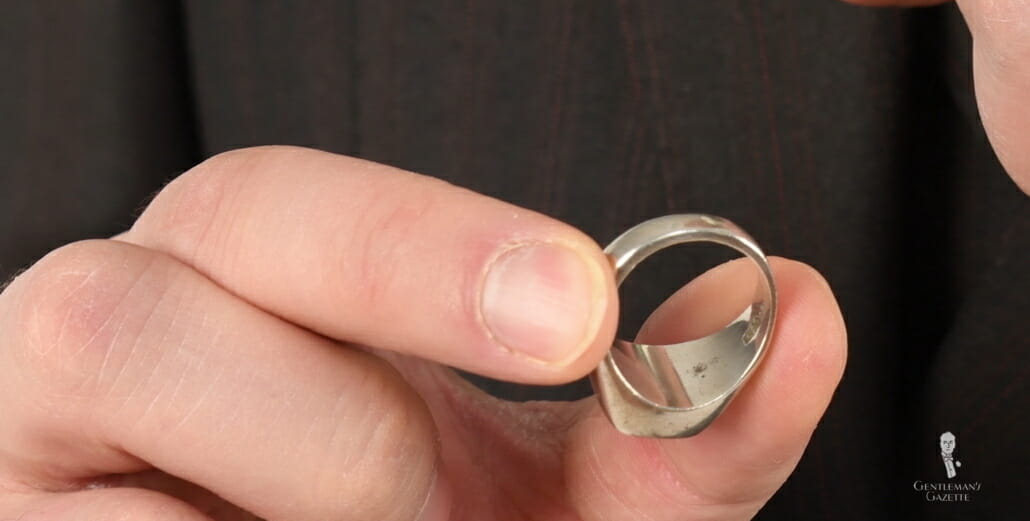
If you have a stone set into the face of your signet ring, the area where the stone meets the band can either be open or closed. If open, you are able to see the underside of the stone, but the resulting cavity tends to collect detritus and is very difficult to clean.
If closed, you cannot see the bottom of the stone, and the additional metal and workmanship will inflate the cost, but the final lines of the ring tend to be more elegant, and it will be easier to keep the ring clean.
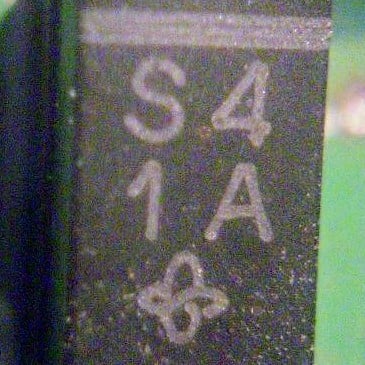
Should you consider
Laser-Engraving?
In recent years, technological advancements have allowed for laser-engraved signet rings. The clean, hard, thin lines of laser-engraving, however, are easily recognizable as not having been done by hand and therefore lack the historic charm of by-hand workmanship. Keep this fact in mind, as much of the appeal of the signet ring is its historical allure.
Additional Details
As with any ring, it is possible to have additional decorative work and detailing added to a signet ring beyond the seal on the face. This decoration can include scrollwork on the shoulders, rippling on the band, and the additional setting of gemstones.
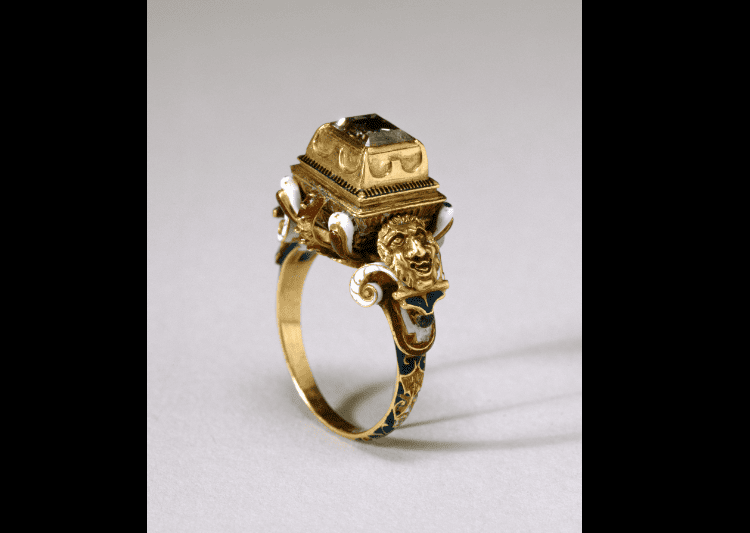
Historically, signet rings were rarely heavily ornamented, as the seal on the face of the ring was intended to be the center of attention. Therefore, if you want to wear a signet ring with traditional appeal, skip showy details like blingy diamonds or heavy scrollwork.
Where to Buy a Signet Ring
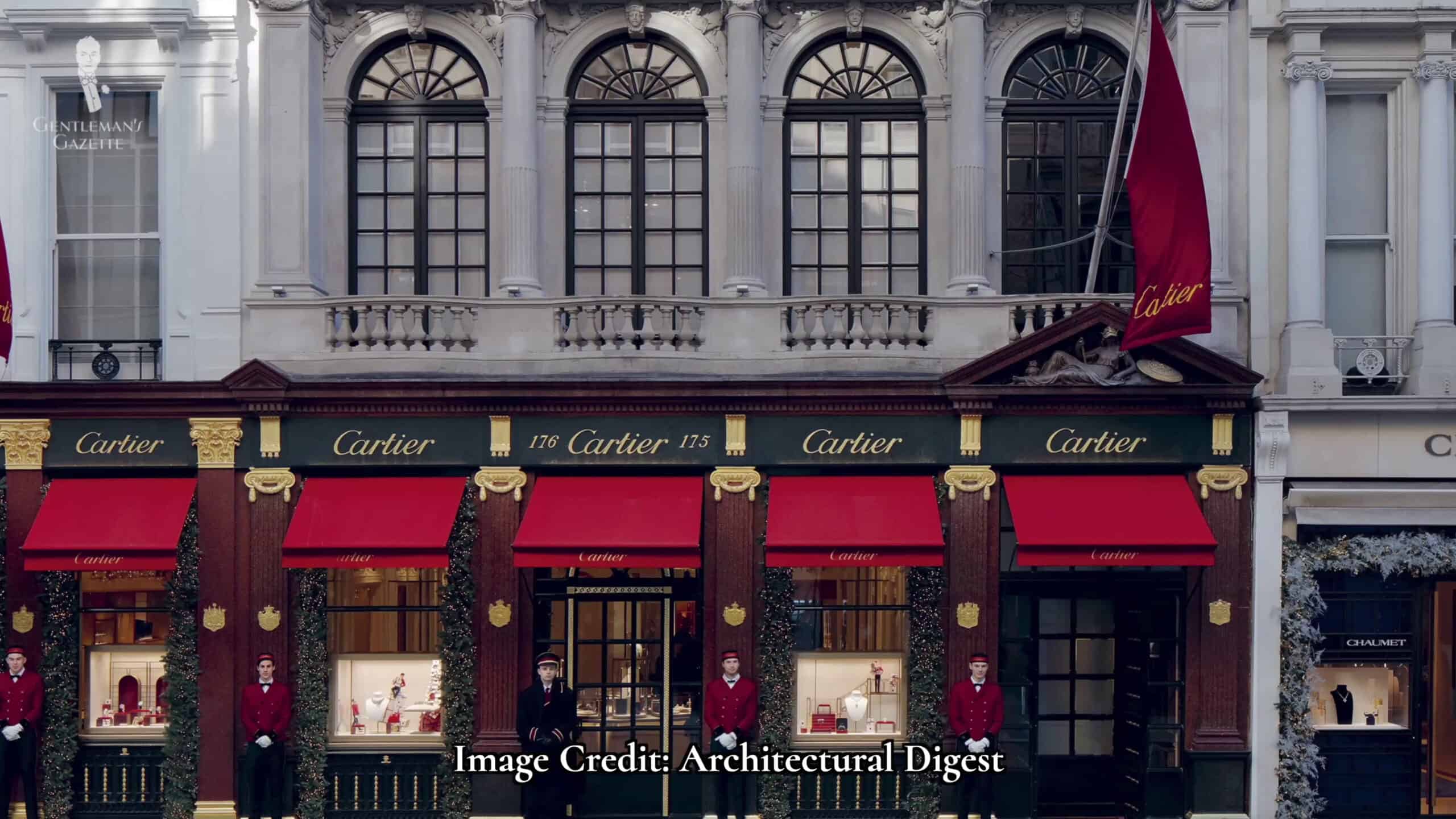
Retail
As signet rings have increased in popularity in recent years, many jewelers offer premade signet rings in a variety of classic and modern styles. These rings often feature generic heraldic emblems, such as stags, lions, and unicorns, or famous coats of arms, such as the royal French fleur-de-lis, the Three Crowns of Munster, or an imperial or republican eagle.

Second-Hand
Having been worn by men for centuries, it makes sense that signet rings are one of the most common ring types found in vintage and second-hand shops today. While it may take some hard work and persistent searching, it is possible to find some real treasures on the used ring market, whether shopping online or in a brick-and-mortar store.

Custom
Especially if you are interested in having a personally-designed symbol or crest on the face of your signet ring, a custom ring might be the perfect option for you. Be aware that you will require the services of a reputable custom jeweler, and that you will be paying for both the price of his craftsmanship and the price of the materials. Depending on materials and design, expect to pay $2000 to $5000, or more, for a custom signet ring.
Benefit from our secrets for successful second-hand shopping!
Conclusion
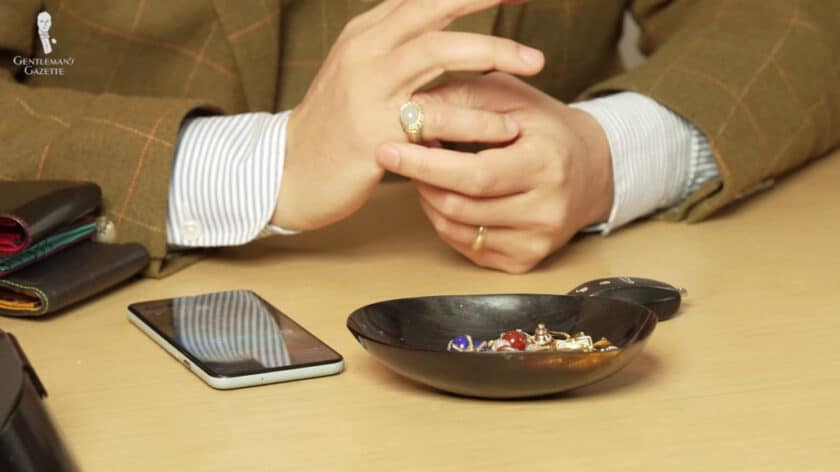
Whether you wear it as a status symbol, for authentication, or simply because it was handed down to you, a signet ring is a beautiful mark of an elegant gentleman that has truly stood the test of time. We hope that you have enjoyed this short primer on signet rings and that you now know enough to consider wearing this timeless menswear accessory yourself.
If you own a signet ring, tell us about it in the comments below!
Outfit Rundown
In today’s outfit, Raphael is wearing a charcoal-brown three-piece suit with a fine red stripe. The suit is single-breasted with peaked lapels and the waistcoat is double-breasted. His shirt is a light green with a white winchester collar and gold monkey’s fist cufflinks from Fort Belvedere. Ironically, Raphael is not wearing a signet ring, but he is wearing a gold pinky ring that sets off his cufflink and features a domed green tourmaline.
Raphael’s tie features bottle green and pearl grey houndstooth and is made from an elegantly textured bourette silk. To harmonize with the green elements in this ensemble, Raphael is wearing over-the-calf mid-brown and green shadow-striped socks. His shoes are medium-brown leather oxfords with brogue detailing and captoe and mid-brown dress shoe laces.
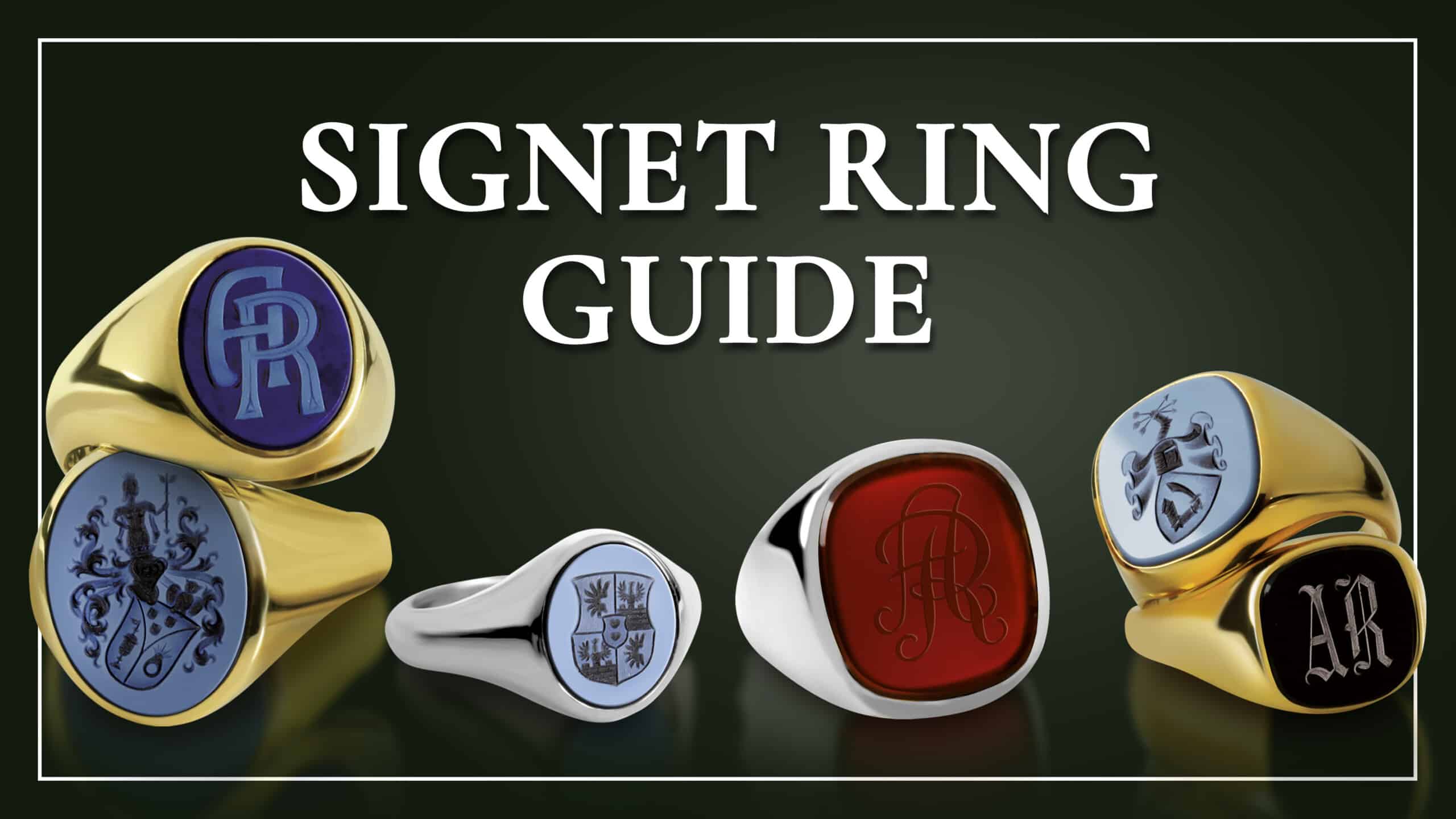



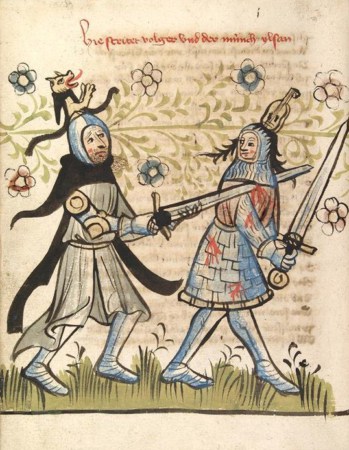


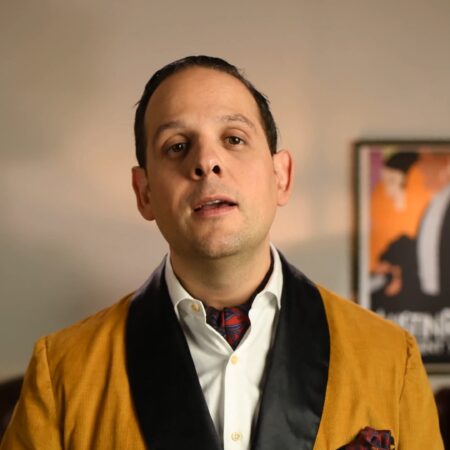
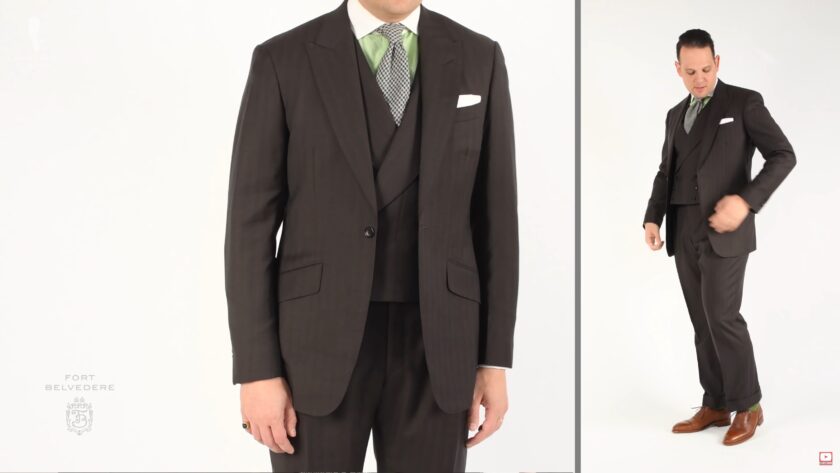
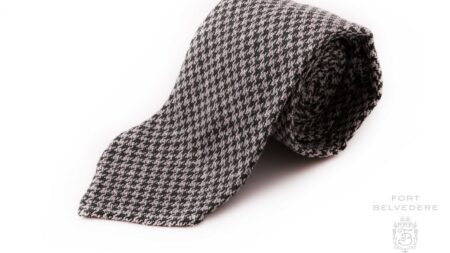
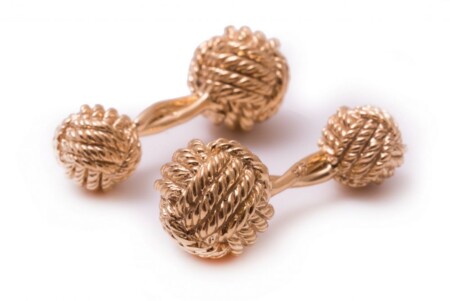
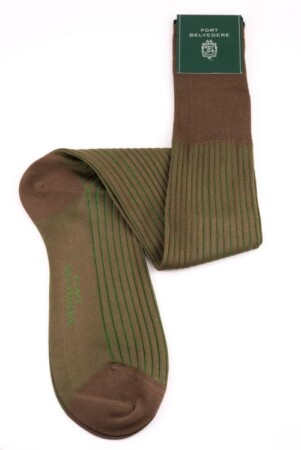
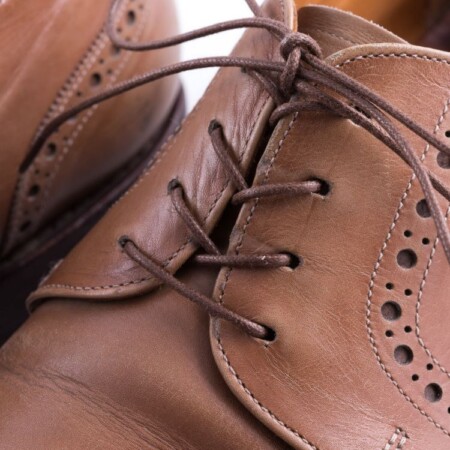
English gentlemen wear their signet rings on the small finger of their left hand and German (and many American) gentlemen on the third finger of their left hand — anyone know where these traditions arose?
@George3d Possibly because English rings typically show a crest only, rather than full coat of arms or armorial shield, and can thus be smaller. The PoW’s ring shows the Feathers of his emblem only, for example. A smaller ring can therefore be worn relatively easily on a small finger – and need not be taken off to use for sealing : not so practical if it’s on your 3rd finger.
Even though they are not used anymore for signing stuff, the idea of having a signet ring sounds really classy. I’d buy one!
Nice article, thanks.
I constantly wear a gold signet bearing my initials that was made at Harrods- London in 1962…
Thanks for sharing!
Exquisite as ever. I have to mention an italian ring crafter called stefania nicastro because i think she is second to none. Moreover, i think we should talk about how to wear such a ring, in terms of fingers (first of all) and clothing. There is also the heraldry topic to talk about and the matter of creating an armor or a family crest.
Thanks Alessio.
I so enjoy Gentlemen’s Gazette and your online newsletter. I have put many young men on to your publications which they have found very helpful. Keep up the excellent work!
JCJ
Thank you James!
Thank you for yet another light-heartedly informative article which I have ‘internetted’, if that’s the word, to several of my younger friends. It is quite remarkable, the way they find these matters so intriguing that they can spend a whole evening in my local pub discussing them!
You, Mr Schneider, are fast becoming an accidental contributor to some of life’s more innocent pleasures.
Brent.
They’re definitely classy and although they look great it’s got to take a certain kind of man to be able to pull them off in today’s society- with so many of us now tech obsessed it would seems a bit out of place to wear a signet on one hand while holding a iPhone in the other, it’s definitely better left to the more sophisticated, classier gentleman, those in a completely different league
Here in the UK, signet rings are on the rise, as a bit of a trend. I must advise, however, how a certain class of society view them. I have an inherited, hereditary, peerage title (and coat of arms). Many of my close friends are similarly titled. With a title and coat of arms, one is supposed to wear a ring (though many elect not to –see Prince William). Unfortunately, many of the people with ‘family crest’ rings are putting on a pretension to something they do not own, nor have the right to wear. Many companies will give you a ‘family name crest’ or some other such nonsense –which really doesn’t exist (a true coat of arms must be granted/registered through the College of Arms). It can even have been an inherited ring, as these scam companies have existed for quite some time.
Unfortunately, it is much more complicated than a simple family name trace as well. Many subjects of a local Lord of the Manor, or similar lesser title, did, at one point or another, simply adopt their lord’s family name.
Wearing a signet ring that you are not directly entitled to wear is the mark of a cad, and is seen as extremely pretentious –as today it even borders on a pretension to wear a ring you are entitled to, when many of our current royalty do not.
Personally, a friend of mine, and titled baron, wound up not hiring a well-qualified man for a company the baron owned… as when the baron interviewed the man, he was wearing a ‘family crest’ signet ring to which he was not entitled.
If you elect to wear one, I strongly advise you limit it to that which you are entitled to wear. A masonic ring if you are a mason, a graduation ring from your university, or similar. One should never, however, wear a ring they are not entitled to wear… and if in doubt, don’t!
Good advice Charles, though you make it sound like it is similar to a Dr. title or anything else of that kind, which is simply not true. You can wear fake signet rings all day long without violating the law. Of course, it is preferable to create your own family crest rather than copying someone elses and Heraldry is in fact all very precise and interesting. If one just wants to wear a ring with a stone or an initial, why not. Of course, some people like your friend won’t like it and I can understand them, at the same time it is ok to start new traditions of one’s own. After all, that’s how every family crest started in the first place.
Mr. Schneider,
First allow me to compliment you on yet another wonderful video. I do love watching and learning that which you have to share concerning men’s fashion and the general but uncommon “common sense” of proper gentlemanly behavior. That being said I’m afraid I must entirely agree with Charles, whose title being unknown I apologize for not using.
The abuse of heraldry and the claiming of arms that you bear no official claim too is entirely un-gentlemanly behavior. Granted, it is no longer an actual legal issue, but at one point it most certainly was. For a person or company to claim ownership or proper usage of a particular coat of arms, new or previously established, said arms should be registered with a recognized college of arms (such as the Royal Colleges of Arms of England and Scotland which are both separate entities or the office of the chief herald in Ireland). I myself am an American presently attempting through genealogical research to show lineage to my “family’s” coat of arms and if presently unclaimed do intend to request it through the office of the chief herald in Ireland.
That being said any individual family wishing to create their own or whatever should not be limited in doing so, granted that they respect all the proper rules and standards of heraldry. I personally find it quite unbecoming of a gentleman when the arms they had made on a website has both bearers AND a helm with crest and indicators of peerage. I think what the heraldry subject truly comes down to in that factor is knowing what exactly you’re doing and maintaining the appropriate degree of tact to respect the tradition you’re attempting to engage or enter in to.
I would also tend to agree with Charles, in that you cannot simply ‘create’ a crest for your family, there is an official process. I have no problem with anyone wearing a ring with a monogram or a picture, as long as it doesn’t look like a coat of arms. In the UK at least, there is a set criteria for earning the right to have a family crest, with the unauthorised use of arms being a criminal offence in some parts of the nation. Pretending to be something you are not in this way is extremely snobbish. The right to a coat of arms doesn’t make anyone inherently better or worse, and those without a coat of arms can just as easily create a ring with a tasteful design or picture without pretending to be someone they are not.
I tend to agree with Charles. To me, wearing an item with a crest / coat of arms you are not entitled to, is every bit as unworthy as wearing a fake Rolex. Worse, actually – it’s claiming you are someone you are really not. Similar to adding a “Dr.” or “MBA” to your signature being neither. It’s legal, all right, but it’s very low, certainly not something a gentleman would do.
Having said that, I must admit my bias, since I’m a descendant of minor Russian nobility, heh.
There is no such thing as a “family crest.” An individual is granted a coat of arms, and that may be passed down to a child or modified slightly and passed down to a niece or nephew. Americans who can trace their Scottish or British heritage prior to 1885 in the U.S. may petition the College of Arms for a coat of arms. That is the only authentic way to wear a coat of arms on one’s signet ring. A signet, after all, is one’s signature and should be traceable to a person, not a family.
I hardly like to complain about a song written by George Bernard Shaw to be sung by Dr.Dolittle but as you have been kind enough to plug me again, would you please tell my son to stop singing I’m Getting Married In The Morning. It is infuriating.
I don’t wear a signet ring, but my great-grandmother had a small white gold ring from Germany with a Maltese cross on it. I love the look of it and that it’s been in my family a long time, so I took it to a jeweler and had it enlarged. It looks a little small on the right pinky of my big rough hands, but I look at it every day. I also have old family cuff links and collar bars which I regularly wear now. It’s profound to realize your connection to what went before.
Before I started following you, Sven, I wouldn’t have given such things a second thought. Now they’re part of a much elevated sense of classic attire, good grooming, and gentlemanly behavior which enrich directly my personal life and, indirectly, my professional endeavors. Thank you, Sven!
It’ll be close to 100 F this weekend. Time to break out the linen shirts and seersucker shorts.
Good article. Please stop using the term “at the end of the day” . It is tiresome and trite.
I agree with Charles regarding wearing a ring with a heraldic symbol (either a crest or a shield), in the UK. In the UK, these have to be granted by letters patent from one of HM’s Kings of Arms. Something similar occurs in countries with heraldic authorities, such as Canada, Spain, Republic of Ireland and South Africa. So I would advise not to wear heraldry, unless you are entitled to it. However, you don’t have to be titled, or a peer of the realm to be armigerous, any gentleman or lady in good standing can petition for a grant of arms. In fact Lord Lyon regularly grants arms to virtuous and deserving people of Scottish descent, quite a few of them in America, and very few of them are peers. People who are not armigerous can still wear a suitable signet ring with their monogram or another non heraldic symbol. I have for instance my own and one inherited from my grandfather, who was a jeweller, the latter has the family cypher, which is not heraldic. Of course, in countries where there is not a heraldic authority, people can, and have, for centuries assumed arms. My advise would be, do not design a coat of arms yourself unless you are well acquainted with the precise rules of the art and science of herlady, if you do, you risk having a terrible coat of arms that is not heraldic but resembles a puerile company logo. If in doubt consult somebody who knows. For example the Society of Heraldic Arts. All the best!
I have and wear 2 different signet
rings 1 is custom made for me in
1982 18ct gold and the other one in silver that my late wife gave me in 2004. I like to wear only one at any giving time. The only other ring i wear is my dad’s ww 2 submarine ring, whicj i only take off to clean and polish once a month.I do not like wearing more than 2 rings at one time.
I’ll get a signet ring when I get my old family estate back – until that time it’s pretension.
The British think we’re very funny that we have Jr., 1st, 2nd and 3rd. – again – talk about pretension?
The same way with having crests on the a blazer. Why? It’s in the same class as having a T-Shirt announcing you’ve been somewhere.
If you’re really classy you don’t have to advertise it – just look like a gentleman without the icing!
The downside of monograms is it makes things hard to pawn – you get less money!
I don’t wear rings but, at the end of the day, still found this article very interesting. Thank you.
I don’t believe I know Charles, and my title is not UK, but last I heard, The Lord Lyon possessed the authority to criminally charge usurpers of Scots arms. I don’t believe a case has been called for many years. I’ve a signet which I do use to seal cards. I’ll confess that coloured hot glue is tidier, easier to work with, and a good bit less incendiary than wax.
Wonderful article..I wear always a signet ring. Please stop using that phrase ..”at the end of the day”.
As usual, an excellent and thorough article that reflects your deep knowledge and passion for history. I never wore rings but maybe I will do it; in that case, it would be more likely of a military character. I do agree with Charles, the titled gentleman from the UK, people wearing rings that make bogus claims of nobility are fools or, better even, cads (such an old-fashioned word, but how descriptive)
I’m probably in a distinct minority, but I find such relics of an age when wealth and status were conferred through inheritance rather than earned by merit to be more than a little pretentious and – for lack of a better term – ‘precious’. While it is a fine thing to be proud of the accomplishments of one’s forebears, I tend to doubt that most people are particularly impressed by this form of overt display of supposed genetic superiority…
Raphael, there was one note in this otherwise fantastic article which I feel a need to quibble about. You assert that traditionalists would frown upon assumed arms, yet outside of the UK and Commonwealth realms, assumed arms are and were the norm, at least among burghers, such as in your native Germany (from whence my paternal ancestors also come). Arms were assumed even among some of the most noted figures, such as Dührer, as well as individuals without full rights (Jews, such as the Rothschild family were identified by the coat of arms associated with their house within the Judengaße, at least in Frankfurt a/M).
Respectively,
Noah
I want to purchase a signer ring as a wedding ring. What do you think.
I want to purchase a signet ring as a wedding ring. What do you think.
こんにちは。
パワハラ指切断でおなじみのド屑県香川のド屑企業フジフーヅでございます。
裁判も会社ぐるみで偽証をして無事乗り切ったド屑でございます。
餃子シュウマイなどをスーパーで販売しております。
店頭で見かけましたらそのときはご購入のほどどうかよろしくお願い致します。
It would have been nice to credit the makers of the signet rings you have used in this article.
I notice Rebus gets a mention but not Signet Circle who made the lovely large gold oval seal engraved Coat of Arms signet with wax impression.
I enjoyed your article.